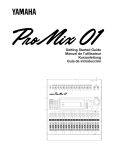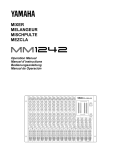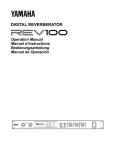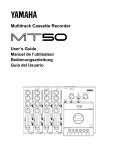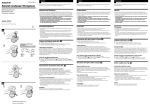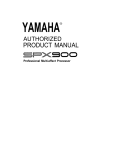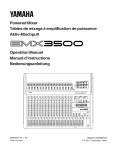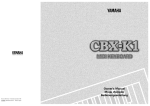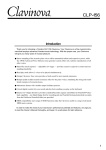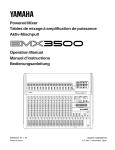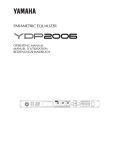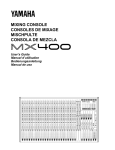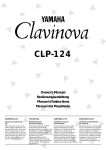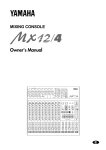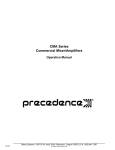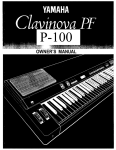Download Yamaha MM 1402 Musical Instrument User Manual
Transcript
MIXER MELANGEUR MISCHPULTE MEZCLA Operation Manual Manuel d’instructions Bedienungsanleitung Manual de Operación LINE IN MIC IN 1 2 3 4 5 SUB IN +4dB TAPE IN –10dBV REC OUT –10dBV ST OUT +4dB 6 L L L L R R R R AUX RETURN –10dB AUX SEND +4dB MONI OUT +4dB LINE IN 1 2 3 4 5 6 –14 –60 +10 GAIN –36 –14 –60 +10 GAIN –36 –14 –60 +10 GAIN –36 –14 –60 +10 GAIN –36 –14 –60 +10 GAIN –36 –14 –60 +10 GAIN –36 –15 –15 –15 –15 –15 –15 7L MONO 9L MONO 11L MONO 13L MONO 1L MONO 8R 10R 12R 14R 1R +4dB –20dB –10dB +4dB –20dB –10dB +4dB –20dB –10dB +4dB –20dB –10dB –15 –15 –15 –15 2L MONO 2R 1 L 2 R L PHANTOM HIGH +15 HIGH +15 HIGH +15 HIGH +15 HIGH +15 HIGH +15 HIGH +15 HIGH +15 HIGH +15 HIGH +15 00 –20 –15 –10 –6 –3 0 +2 +4 +6 R PFL STEREO GRAPHIC EQUALIZER –15 –15 MID LOW +15 –15 +15 –15 10 0 10 0 R L MID LOW +15 –15 +15 –15 10 0 10 0 R L MID LOW +15 –15 +15 –15 10 0 10 0 R L MID LOW +15 –15 +15 –15 10 0 10 0 R L MID LOW +15 –15 +15 –15 10 0 10 0 R L MID LOW +15 +15 –15 10 0 LOW +15 –15 10 0 LOW +15 –15 10 0 LOW +15 –15 10 0 LOW +15 +12 9 6 3 0 3 6 9 –12 +12 9 6 3 0 3 6 9 –12 100 0 0 L AUX 1 AUX 2 PAN PEAK AUX 1 AUX 2 PAN PEAK PFL AUX 1 AUX 2 PAN PEAK PFL AUX 1 AUX 2 PAN PEAK PFL AUX 1 AUX 2 PAN PEAK PFL AUX 1 AUX 2 PAN AUX 1 AUX 1 AUX 1 10 10 R L R BALANCE PEAK PEAK PFL AUX 1 PFL L R BALANCE PEAK PFL L R BALANCE PEAK PFL L R BALANCE PEAK PFL 400 1k 5k 0 10 AUX SEND 1 0 10 AUX SEND 2 0 10 AUX RETURN 1 0 10 AUX RETURN 2 2 3 4 5 6 7 8 9 10 11 12 13 PFL 14 10 10 10 10 10 10 10 10 10 10 5 5 5 5 5 5 5 5 5 5 5 0 0 0 0 0 0 0 0 0 10 TAPE IN R L 10 0 0 TO MONI STEREO 1 10k MIXER 0 10 MONITOR 0 5 5 5 5 5 5 5 5 5 5 5 10 10 10 10 10 10 10 10 10 10 10 15 15 15 15 15 15 15 15 15 15 15 20 30 20 30 20 30 20 30 20 30 20 30 20 30 20 30 20 30 20 30 20 30 00 00 00 00 00 00 00 00 00 00 00 0 10 PHONES FCC INFORMATION (U.S.A.) 1. IMPORTANT NOTICE: DO NOT MODIFY THIS UNIT! This product, when installed as indicated in the instructions contained in this manual, meets FCC requirements. Modifications not expressly approved by Yamaha may void your authority, granted by the FCC, to use the product. 2. IMPORTANT: When connecting this product to accessories and/or another product use only high quality shielded cables. Cable/s supplied with this product MUST be used. Follow all installation instructions. Failure to follow instructions could void your FCC authorization to use this product in the USA. 3. NOTE: This product has been tested and found to comply with the requirements listed in FCC Regulations, Part 15 for Class “B” digital devices. Compliance with these requirements provides a reasonable level of assurance that your use of this product in a residential environment will not result in harmful interference with other electronic devices. This equipment generates/uses radio frequencies and, if not installed and used according to the instructions found in the users manual, may cause interference harmful to the operation of other electronic devices. Compliance with FCC regulations does not guarantee that interference will not occur in all installations. If this product is found to be the source of interference, which can be determined by turning the unit “OFF” and “ON”, please try to eliminate the problem by using one of the following measures: Relocate either this product or the device that is being affected by the interference Utilize power outlets that are on different branch (circuit breaker of fuse) circuits or install AC line filter/s. In the case of radio or TV interference, relocate/reorient the antenna. If the antenna lead-in is 300 ohm ribbon lead, change the lead-in to coaxial type cable. If these corrective measures do not produce satisfactory results, please contact the local retailer authorized to distribute this type of product. If you can not locate the appropriate retailer, please contact Yamaha Corporation of America. Electronic Service Division, 6600 Orangethorpe Ave, Buena Park, CA 90620 * This applies only to products distributed by YAMAHA CORPORATION OF AMERICA CANADA Dette apparat overholder det gaeldende EF-direktiv vedtrørende radiostøj. THIS DIGITAL APPARATUS DOES NOT EXCEED THE “CLASS B” LIMITS FOR RADIO NOISE EMISSIONS FROM DIGITAL APPARATUS SET OUT IN THE RADIO INTERFERENCE REGULATION OF THE CANADIAN DEPARTMENT OF COMMUNICATIONS. Cet appareil est conforme aux prescriptions de la directive communautaire 87/308/CEE. Diese Geräte entsprechen der EG-Richtlinie 82/499/EWG und/ oder 87/308/EWG. LE PRESENT APPAREIL NUMERIQUE N’EMET PAS DE BRUITS RADIOELECTRIQUES DEPASSANT LES LIMITES APPLICABLES AUX APPAREILS NUMERIQUES DE LA “CLASSE B” PRESCRITES DANS LE REGLEMENT SUR LE BROUILLAGE RADIOELECTRIQUE EDICTE PAR LE MINISTERE DES COMMUNICATIONS DU CANADA. This product complies with the radio frequency interference requirements of the Council Directive 82/499/EEC and/or 87/308/ EEC. Questo apparecchio è conforme al D.M.13 aprile 1989 (Direttiva CEE/87/308) sulla soppressione dei radiodisturbi. Este producto está de acuerdo con los requisitos sobre interferencias de radio frequencia fijados por el Consejo Directivo 87/308/CEE. YAMAHA CORPORATION IMPORTANT NOTICE FOR THE UNITED KINGDOM Connecting the Plug and Cord WARNING: THIS APPARATUS MUST BE EARTHED IMPORTANT: The wires in this mains lead are coloured in accordance with the following code: GREEN-AND-YELLOW : EARTH BLUE : NEUTRAL BROWN : LIVE As the colours of the wires in the mains lead of this apparatus may not correspond with the coloured markings idenlifying the terminals in your plug, proceed as follows: The wire which is coloured GREEN and YELLOW must be connected to the terminal in the plug which is marked by the letter E or by the safety earth symbol or coloured GREEN and YELLOW. The wire which is coloured BLUE must be connected to the terminal which is marked with the letter N or coloured BLACK. The wire which is coloured BROWN must be connected to the terminal which is marked with the letter L or coloured RED. * This applies only to products distributed by YAMAHA KEMBLE MUSIC (U.K.) LTD. * This applies only to products distributed by YAMAHA CANADA MUSIC LTD. Litiumbatter! Bör endast bytas av servicepersonal. Explosionsfara vid felaktig hantering. VAROITUS! Lithiumparisto, Räjähdysvaara. Pariston saa vaihtaa ainoastaan aian ammattimies. ADVARSELl! Lithiumbatter! Eksplosionsfare. Udskiftning må kun foretages af en sagkyndig, –og som beskrevet i servicemanualen. English MIXER OPERATION MANUAL Dit produkt is gefabriceerd in overeenstemming met de radiostoringsvoorschriften van de Richtlijn van de Raad (82/499/ EEG). AYTH H ΣYΣKEYH ANTAΠOKPINETAI ΣTIΣ AΠAITHΣEIΣ TΩN O∆HΓIΩN THΣ EYPΩΠAIKHΣ OIKONOMIKHΣ KOINOTHTAΣ 82/499/E.O.K.. Este produto está de acordo com o radio de interferencia frequente requiridos do Conselho Diretivo 82/499/EEC. Dette apparat overholder det gaeldende EF-direktiv vedrørende radiostøj. Cet appareil est conforme aux prescriptions de la directive communautaire 87/308/CEE. IMPORTANT NOTICE FOR THE UNITED KINGDOM Connecting the Plug and Cord IMPORTANT: The wires in this mains lead are coloured in accordance with the following code: Diese Geräte entsprechen der EG-Richtlinie 82/499/EWG und/ oder 87/308/EWG. This product complies with the radio frequency interference requirements of the Council Directive 82/499/EEC and/or 87/308/ EEC. Questo apparecchio è conforme al D.M.13 aprile 1989 (Direttiva CEE/87/308) sulla soppressione dei radiodisturbi. BLUE BROWN : NEUTRAL : LIVE As the colours of the wires in the mains lead of this apparatus may not correspond with the coloured markings identifying the terminals in your plug, proceed as follows: The wire which is coloured BLUE must be connected to the terminal which is marked with the letter N or coloured BLACK. The wire which is coloured BROWN must be connected to the terminal which is marked with the letter L or coloured RED. Este producto está de acuerdo con los requisitos sobre interferencias de radio frequencia fijados por el Consejo Directivo 87/308/CEE. Making sure that neither core is connected to the earth terminal of the three pin plug. YAMAHA CORPORATION * This applies only to products distributed by YAMAHA KEMBLE MUSIC (U.K.) LTD. Introduction Thank you for purchasing the Yamaha MM1402 mixer. The MM1402 is a mixer that provides 6 MONO IN channels and 4 STEREO IN channels, for a total of 14 inputs. It is a console-type stereo mixer suitable for a wide variety of input sources. Features ● The six MONO IN channels feature two types of input jack; XLR type MIC IN jacks (continuously variable over –14 ~ –60 dB, balanced) and TRS phone LINE IN jacks (continuously variable over +10 ~ –36 db, balanced). The MIC IN jacks are also able to provide +48 V phantom power for condenser mics. ● Each of the four STEREO IN channels features L/MONO and R phone jacks (switchable – 20/–10/+4 dB, unbalanced), two band equalization, and an AUX SEND (PRE) system, meeting the requirements of a wide variety of sources. ● Two AUX return systems are provided for use as effect unit returns or stereo source inputs. TAPE IN and REC OUT jacks are also provided for recording/playback on a stereo recorder. ● All of the 14 inputs provide a PFL (pre fader listen) switch, allowing you to monitor the signal or input level using headphones or MONITOR OUT. ● A five-band master graphic equalizer is provided in the STEREO OUT stage, allowing equalization of the overall output for sound field compensation or feedback prevention. Contents Precautions ............................................................................ 1 Control panel ......................................................................... 2 Channel control section (mono input section) .................................................. 2 (Stereo input section) ................................................. 3 Master control section ...................................................... 4 Panel ...................................................................................... 6 Application Example ............................................................. 7 Specifications ........................................................................ 8 General Specifications ..................................................... 8 Input Specifications ......................................................... 9 Output Specifications ....................................................... 9 Dimensions ...................................................................... 9 Block and Level Diagrams ............................................ 10 Precautions 1. Location Keep the unit away from locations where it is likely to be exposed to high temperatures or humidity — such as near radiators, stoves, etc. Also avoid locations which are subject to excessive dust accumulation or vibration which could cause mechanical damage and locations subject to strong electromagnetic fields, such as close to broadcast equipment. 5. Always power off before making connections Always turn the power OFF before connecting or disconnecting cables. This is important to prevent damage to the unit itself as well as other connected equipment. 2. Ventilation The unit has ventilation slots on the side and bottom panels. Do not block these vents. 7. Clean With a Soft Dry Cloth Never use solvents such as benzine or thinner to clean the unit. Wipe clean with a soft, dry cloth. 3. Avoid Physical Shocks Strong physical shocks to the unit can cause damage. Handle it with care. 8. Always Use the Correct Power Supply Make sure that the power supply voltage specified on the rear panel matches your local AC mains supply. Also make sure that the AC mains supply can deliver more than enough current to handle all equipment used in your system. 4. Do Not Open the Case or Attempt Repairs or Modifications Yourself This product contains no user-serviceable parts. Refer all maintenance to qualified Yamaha service personnel. Opening the case and/or tampering with the internal circuitry voids the warranty. 6. Handle Cables Carefully Always plug and unplug cables — including the AC power cord — by gripping the connector, not the cord. 1 Control panel ■ Channel control section (mono input section) 1 –14 –60 +10 GAIN –36 –15 HIGH +15 2 –15 –15 0 0 MID LOW AUX 1 AUX 2 +15 +15 10 3 10 4 L PAN R PEAK 5 PFL 6 1 1 GAIN control Use this knob to adjust the level of the input signal to the optimal level. For the best balance of S/N ratio and dynamic range, adjust this knob so that the peak indicator 5 lights occasionally. For mic inputs connected to the XLR connector, the range is –14dB – –60dB. For line inputs connected to the phone connector, the range is +10 – –36dB. 2 HIGH, MID, LOW equalizer (3 band) These knobs control high, mid and low equalization at the following frequencies. HIGH: 12kHz, maximum effect ±15dB MID: 2.5kHz, maximum effect ±15dB LOW: 80Hz, maximum effect ±15dB When the knob is in the center position, the response will be flat. 3 AUX 1, 2 controls These knobs control the level of the signal that is output to the AUX buses. Since AUX1 is placed before the channel fader, it will be unaffected by the position of the channel fader. Since AUX2 is placed after the channel fader, it will be affected by the channel fader level. By outputting a signal only from AUX SEND 1 or AUX SEND 2 and not from the ST OUT jacks, you can also use these as supplementary outputs. 4 PAN control (panpot) This knob assigns the signal of each channel to the STEREO L and R buses, determining the stereo location of the sound. 5 PEAK indicator This indicator detects the level of the signal at a point after the EQ (pre fader). It will light red at 3dB before clipping to warn that the signal is approaching clipping level. 6 PFL switch (input channel) This switch allows you to monitor the signal of the input channel at the pre fader level. You can use headphones or MONI OUT to conveniently check the input signal of a specific channel, or trouble-shoot a channel that is having problems. 7 Channel fader This fader controls the output level of the input channel signal, adjusting the volume balance between channels. Faders of channels not in use should be pulled down. 10 5 0 PHANTOM OFF (+48V) L R STEREO 1 AUX 2 L R PFL PFL CTRL 7 ON 5 (MIC IN) 10 PHANTOM (PHANTOM) PEAK 15 00 MIC IN 1–6 LINE IN 1–6 HA EQ BA PAN PAD GAIN LOW MID HIGH 20 30 AUX 2 AUX 1 (+V) PFL 2 ■ (Stereo input section) 8 GAIN select switch Use this switch to adjust the sensitivity of the input as appropriate for the level of the input signal. For the best balance of S/N ratio and dynamic range, adjust this switch so that the peak indicator B lights occasionally. +4dB –20dB –10dB +15 9 LOW A Balance control This knob adjusts the left/right location of the stereo input signal. +15 0 0 AUX 1 10 A B PFL C C PFL switch (input channel) This switch allows you to monitor the signal of the input channel at the pre fader level. You can use headphones or MONI OUT to conveniently check the input signal of a specific channel, or trouble-shoot a channel that is having problems. D Channel fader This fader controls the output level of the input channel signal, adjusting the volume balance between channels. Faders of channels not in use should be pulled down. L R STEREO 1 AUX 2 L R PFL PFL CTRL 7 L R BALANCE PEAK B PEAK indicator This indicator detects the level of the signal at a point after the EQ (pre fader). It will light red at 3dB before clipping to warn that the signal is approaching clipping level. 8 HA 10 L/MONO 5 LINE IN 7–14 0 D R +4dB –10dB –20dB EQ HA EQ BA PEAK –15 0 AUX1 control This knob controls the level of the signal that is output to the AUX bus. Since AUX1 is placed before the channel fader, it will be unaffected by the position of the channel fader. By outputting a signal only from AUX SEND 1 and not from the ST OUT jacks, you can also use this as a supplementary output. LOW HIGH 9 HIGH, LOW equalizer (2 band) These knobs control high mid and low equalization at the following frequencies. HIGH: 12kHz, maximum effect ±15dB LOW: 80Hz, maximum effect ±15dB When the knob is in the center position, the response will be flat. HIGH –15 8 BALANCE BA 5 AUX 1 10 15 20 30 (+V) PFL 00 3 ■ Master control section E ST L, R master control These faders adjust the final level of all channels, and output the combined signal to the ST OUT jacks. The OUTPUT LEVEL L, R meters allow you to monitor the L and R outputs. J L PHANTOM K 00 –20 –15 –10 –6 –3 0 +2 +4 +6 I R F AUX RETURN 1-2 controls The knobs control the input levels from the effect units etc. connected to AUX RETURN. Since the signals input at AUX RETURN pass through this control and are then output from the ST OUT jacks, AUX RETURN can be used not only to input the signals from effect units but also as supplementary inputs. PFL STEREO GRAPHIC EQUALIZER +12 9 6 3 0 3 6 9 –12 +12 9 6 3 0 3 6 9 –12 100 400 1k 5k H L/MONO AUX RETURN 1,2 –10dB R HA AUX RETURN 1,2 HA 10k G AUX SEND 1, 2 controls These knobs adjust the level of the signals that are output to AUX SEND 1 and 2. MIXER G 0 10 AUX SEND 1 0 10 AUX SEND 2 0 10 AUX RETURN 1 0 10 AUX RETURN 2 L F 0 10 TAPE IN TO MONI STEREO R L 10 M N 0 10 MONITOR H Graphic equalizer (5 band) Since this equalizer is placed before ST OUT, it allows you to make fine adjustments in equalization to the overall output, for sound field compensation or to prevent feedback. I PFL indicator This indicator will light when a PFL switch is turned ON. J PHANTOM indicator This indicator will light when the PHANTOM switch is ON. 5 0 O 5 10 15 0 10 PHONES 20 30 00 P E K OUTPUT LEVEL L, R meters These meters indicate the output level to the ST OUT jacks. L TAPE input control This knob controls the input signal of the tape deck etc. that is connected to the TAPE IN jacks. M TAPE INPUT select switch This switch selects the destination of the input signal of the tape deck etc. that is connected to the TAPE IN jacks. OFF: sent to the stereo bus ON: sent to MONI OUT (L, R) N MONITOR control This knob adjusts the output level from the MONI OUT jacks. O PHONES control This knob adjusts the volume of the headphones connected to the headphone jack. 4 L R STEREO 1 AUX 2 L R PFL PFL CTRL P PHONE jack A set of stereo headphones can be connected to this jack. Normally, the headphones will monitor the same signal as the STEREO OUT jacks, but the following two signals can also be monitored. 1. When a 8 PFL switch is turned on, the signal of the input channel after the equalizer will be monitored. 2. When the M TAPE input select switch is turned on, the signal input to the TAPE IN jacks will be monitored. METER 5k INV L (MONI) 10k 400 100 1k GEQ SUM ST OUT +4dB METER GEQ SUM INV R (MONI) PAD PAD SUM AUX SEND 1 L REC OUT –10dBV R 1 AUX SEND +4dB SUM AUX SEND 2 2 MONITOR MONI OUT +4dB (ST L) PFL L HA BA L TAPE IN –10dBV R HA (ST R) TO MONI TAPE IN BA R L/MONO AUX RETURN 1,2 –10dB R HA SUM INV SUM INV AUX RETURN 1,2 HA PHONES L SUB IN +4dB R 5 Panel 1 LINE IN MIC IN 1 2 3 4 5 0 9 8 7 SUB IN +4dB TAPE IN –10dBV REC OUT –10dBV ST OUT +4dB 6 L L R R AUX RETURN –10dB L L R R AUX SEND +4dB MONI OUT +4dB LINE IN 1 2 3 4 5 6 2 1 MIC IN These are XLR type connectors to which microphones can be connected (1: GND, 2: hot, 3: cold). The nominal impedance is 50–600Ω. Turn the PHANTOM switch ON to apply +48V DC to Pin 2 and 3 of MIC IN connectors 1–6. 2 LINE IN (1–6) These are balanced phone connectors to which line-level equipment can be connected (T: hot, R: cold, S: GND). The nominal impedance is 600Ω. 3 LINE IN (7L–14R) These are unbalanced phone jacks to which line level devices can be connected. They are used as four sets of stereo inputs (7L, 8R)–(13L, 14R). If only the L jack is used, the input signal will be mono and the same signal will be input to the R jack as well. 4 AUX SEND (1, 2) These are unbalanced phone jacks. The nominal output level and nominal impedance are +4dB/600Ω. 5 AUX RTN (1, 2) These are unbalanced phone jacks. The nominal output level and nominal impedance are – 10dB/600Ω. They are used as two sets of stereo inputs (1L, 1R)–(2L, 2R). If only the L jack is used, the input signal will be mono and the same signal will be input to the R jack as well. 6 MONI OUT (L, R) These are unbalanced phone jacks to which the power amp driving your monitor speakers can be connected. They output the same signal as the PHONE jack located on the control panel. 7 ST OUT (L, R) These are unbalanced phone jacks to which the power amp driving your main speakers can be connected. 6 7L MONO 9L MONO 11L MONO 13L MONO 1L MONO 2L MONO 1 L 8R 10R 12R 14R 1R 2R 2 R 3 5 4 6 Phantom Power Warning To prevent hazard or damage, connect only microphones and cables that conform to the IEC288-15A standard. 8 REC OUT (L, R) These jacks output the signal from before the ST OUT (L, R) faders. 9 TAPE IN (L, R) These jacks are used as inputs for a sound source such as a tape recorder. 0 SUB IN (L, R) These are supplementary inputs. The signal input here is sent to the stereo bus. A B POWER PHANTOM ON ON OFF OFF A POWER switch This switch turns the power on. B PHANTOM switch This switch turns the phantom power on/off for all channels. Use this when you are using condenser microphones. When this switch is turned on, DC +48 V will be supplied to pins 2 and 3 of each input MIC IN 1–6. If your microphones do not require phantom power, be sure to turn this switch off. * Although it is safe to connect balanced dynamic microphones or line level devices when the PHANTOM switch is on, connecting unbalanced devices or devices whose transformer is center grounded will cause hum or malfunctions. Application Example Front of House Main Speakers Stage Monitors Power Amp Graphic EQ Power Amp Effects Processor AUX SEND1 AUX SEND2 AUX RETURN L/R STEREO OUT Cassette Recorder REC OUT L/R CD Player TAPE IN L/R MIXER Headphones MIC IN LINE IN L/R LINE IN L/R HEAD PHONES Line Level Sources Mics Guitar Effect Processor 7 Specifications ■ General Specifications Maximum output level +20dB* (ST OUT L/R) +20dB* (AUX SEND 1–2) Total harmonic distortion < 0.1% @+14dB* 20Hz–20kHz (ST OUT L/R @600Ω, AUX SEND 1–2 @600Ω) Frequency response 20Hz–20kHz +1dB, –2dB @+4dB* (ST OUT L/R @600Ω, AUX SEND 1–2 @600Ω) Hum and noise (Average, Rs=150Ω) (20Hz–20kHz) –127dB* –95dB* Equivalent input noise (INPUT 1–6) Residual output noise (ST OUT L/R @600Ω, AUX SEND 1–2 @600Ω) –78dB*(ST OUT L/R) Master fader: All channel fader: nominal minimum –63dB*(67dB S/N)(ST OUT L/R) Master fader: One channel fader: nominal nominal –78dB*(AUX SEND 1–2) Master level control: All channel AUX level control: nominal minimum –63dB*(67dB S/N)(AUX SEND 1–2) Master level control: One channel fader: One channel AUX control: nominal nominal INPUT (1–6) → ST OUT INPUT (7L–14R) → ST OUT INPUT (1–6) → AUX SEND1 INPUT (1–6) → AUX SEND2 INPUT (1–6) → REC OUT INPUT (1–6) → MONITOR OUT (PFL SW ON) AUX RETURN → ST OUT SUB IN → ST OUT TAPE IN → ST OUT Maximum voltage gain 84dB 44dB 76dB 86dB 62dB 70dB 30dB 10dB 28dB Crosstalk –70dB @ 1kHz adjacent input channels –70dB @ 1kHz adjacent output channels Gain control (1–6) 46dB variable range INPUT (7L–14R) Input Level Selector +4/–10/–20dB* INPUT (1–6) Channel equalization ±15dB maximum boost or cut HIGH 12kHz shelving MID 2.5kHz peaking LOW 80Hz shelving INPUT (7L–14R) Channel equalization ±15dB maximum boost or cut HIGH 12kHz shelving LOW 80Hz shelving ST OUT Graphic EQ ±12dB at 100, 400, 1k, 5k, 10kHz LED meters 0dB=+4dB* Output level Channel PEAK indicators Red LED on each channel lights when post-EQ signal reaches 3dB below clip level. Phantom power +48V, DC Power requirements US & Canadian Models: General Model: AC 120V, 60Hz AC 230V, 50Hz Power consumption US & Canadian Models: General Model: 40W 40W Dimensions (W × H × D) 430 × 104.9 × 360.1 mm Weight 6.5kg * 0dB=0.775Vrms. 8 @600Ω, 0.5% THD at 1kHz @600Ω, 0.5% THD at 1kHz ■ Input Specifications Input Gain Trim Input impedance Nominal level Maximum nonclipping level –80dB (77.5µV) –60dB (775µV) –40dB (7.75mV) –34dB (15.5mV) –14dB (0.155V) +6dB (1.55V) –56dB (1.23mV) –36dB (12.3mV) –16dB (0.123V) –10dB (0.245V) +10dB (2.45V) +30dB (24.5V) Phone jack Balanced T=hot R=cold S=GND –40dB (7.75mV) –20dB (77.5mV) 0dB (0.775V) Phone jack Unbalanced –10 –30dB (24.5mV) –10dB (0.245V) +10dB (2.45V) +4 –16dB (0.123V) +4dB (1.23V) +24dB (12.3V) MAX 2.5kΩ 50–600Ω microphone MIN MAX 47kΩ 600Ω line LINE IN (1–6) MIN –20 INPUT Input level Sensitivity MIC IN (1–6) Nominal impedance 10kΩ 600Ω line (7L–14R) AUX RETURN (1L–2R) — SUB IN (L/R) — TAPE IN (L/R) — Connector type XLR-3-31 type Balanced 1=GND 2=hot 3=cold 10kΩ 600Ω line –26dB (38.8V) –10dB (0.245V) +20dB (7.75V) Phone jack Unbalanced 10kΩ 600Ω line –6dB (0.388V) +4dB (1.23V) +24dB (12.3V) Phone jack Unbalanced 10kΩ 600Ω line –26dBV (50.1mV) –10dBV (316mV) +18dBV (7.75V) RCA pin jack Unbalanced 0dB=0.775Vrms., 0dBV=1Vrms ■ Output Specifications Output level Output impedance Nominal impedance Nominal level Maximum nonclipping level ST OUT (L/R) 75Ω 600Ω Lines +4dB (1.23V) +20dB (7.75V) Phone jack AUX SEND (1–2) 75Ω 600Ω Lines +4dB (1.23V) +20dB (7.75V) Phone jack MONITOR OUT (L/R) 75Ω 600Ω Lines +4dB (1.23V) +20dB (7.75V) Phone jack REC OUT (L/R) 600Ω 10Ω Lines –10dBV (316mV) +10dBV (3.16V) RCA pin jack HEAD PHONE 100Ω 40Ω Phones 3mW 120mW Stereo phone jack Output Connector type 0dB=0.775Vrms., 0dBV=1Vrms Outputs are unbalanced ■ Dimensions 318 H:104.9 93.4 7.6 357.4 271.8 357.6 D:360.1 43.2 3.9 Units: mm 397 W:430 Specifications and appearance subject to change without notice. 78.5 9 ■ Block and Level Diagrams PHANTOM L R STEREO 1 AUX 2 L R PFL PFL CTRL (+48V) ON PHANTOM (PHANTOM) METER BA EQ PAD GAIN GEQ SUM INV L AUX 2 AUX 1 5k LINE IN 1–6 LOW MID HIGH PAN (MONI) 10k HA 1k MIC IN 1–6 PEAK 400 (MIC IN) 100 OFF ST OUT +4dB METER (+V) GEQ SUM PFL INV R (MONI) HA R PAD BA PEAK LINE IN 7–14 EQ LOW +4dB –10dB –20dB HIGH HA L / MONO REC OUT –10dBV PAD BALANCE EQ L R SUM BA 1 AUX SEND 1 AUX SEND +4dB AUX 1 SUM 2 AUX SEND 2 (+V) (ST L) PFL PFL L HA BA L TAPE IN –10dBV R HA (ST R) TO MONI TAPE IN MONITOR MONI OUT +4dB BA R L/MONO AUX RETURN 1,2 –10dB R HA SUM INV SUM INV AUX RETURN 1,2 HA PHONES L SUB IN +4dB R [dB] +10 LINE IN 1–6[+10] ST OUT AUX SEND LINE IN 7–14[+4] 0 –10 –20 ST AUX LINE IN 7–14[–10] MIC IN[–14] LINE IN 7–14[–20] –30 [dB] +10 0 AUX ST –10 –20 –30 LINE IN 1–6[–36] –40 –40 –50 –60 10 –50 MIC IN[–60] –60 Français MELANGEUR MANUEL D’INSTRUCTIONS Introduction Nous vous remercions d’avoir porté votre choix sur le mélangeur MM1402 de Yamaha. Le MM1402 vous propose 6 canaux MONO IN et 4 canaux STEREO IN, un total de 14 bornes donc. Il s’agit d’un mélangeur stéréo de type console adapté pour une large variété de sources d’entrée. Caractéristiques ● Les six canaux MONO IN ont deux types de bornes d’entrée: Bornes MIC IN de type XLR (variables de façon continue sur –14 ~ –60 dB, symétriques) et des prises casque LINE IN TRS (variables de façon continue sur +10 ~ –36 dB, symétriques). Les bornes MIC IN peuvent également fournir une alimentation fantôme de +48 V pour micros à condensateur. ● Chacun des quatre canaux STEREO IN est doté de prises casque L/MONO et R (commutables –20/–10/+4 dB, asymétriques), d’une égalisation de deux bandes et d’un système AUX SEND (PRE) qui permet de répondre aux exigences d’un grand nombre de sources. ● Deux systèmes de retours AUX sont disponibles; vous pouvez les utiliser comme retours de processeurs d’effets ou comme entrées pour source stéréo.Les bornes TAPE IN et REC OUT vous permettent d’enregistrer ou de reproduire sur enregistreur stéréo. ● Les 14 bornes sont pourvues d’un commutateur PFL (pre fader listen/écoute avant curseur) vous permettant de contrôler le signal ou le niveau d’entrée via le casque ou MONITOR OUT. ● Un égaliseur master cinq bandes est prévu à l’étage STEREO OUT. Il permet une égalisation générale du signal de sortie afin d’effectuer des compensations dans le champ sonore ou pour éviter tout phénomène de rétroaction (feedback). Table des matières Précautions ............................................................................ 1 Panneau de commandes ......................................................... 2 Section du contrôle de canal (section d’entrée mono) .............................................. 2 (Section d’entrée stéréo) ............................................ 3 Section Master ................................................................. 4 Panneau .................................................................................. 6 Exemple d’application ........................................................... 7 Caractéristiques ..................................................................... 8 Caractéristiques générales ................................................ 8 Caractéristiques d’entrée .................................................. 9 Caractéristiques de sortie ................................................. 9 Dimensions ...................................................................... 9 Schémas de connexions et de niveaux ........................... 10 Précautions 1. Emplacement Ne placez pas l’appareil dans un endroit où il risque d’être exposé à des températures élevées ou une forte humidité (évitez la proximité de radiateurs, poêles, etc). Evitez également les endroits poussiéreux ou soumis à des vibrations qui peuvent être à l’origine de dommages mécaniques ainsi que les endroits sujets à des champs magnétiques importants, tels que la proximité de matériel de transmission. 2. Ventilation L’appareil est pourvu de fentes d’aération sur les panneaux latéraux et inférieur. Ne bloquez jamais ces fentes. 3. Evitez tout choc Un choc relativement important peut endommager l’appareil. Maniez-le donc avec soin. 4. N’ouvrez pas le boîtier et n’essayez pas d’effectuer des réparations vous-même Cet appareil ne contient pas d’élément pouvant être réparé par l’utilisateur. Veuillez donc confier toute réparation à un technicien Yamaha qualifié. Toute tentative d’ouverture du boîtier et de manipulation des circuits internes se soldera par la perte du bénéfice de la garantie. 5. Coupez toujours l’alimentation avant de procéder à des branchements N’oubliez jamais de mettre les appareils hors tension avant de brancher ou de débrancher des câbles afin de ne pas endommager l’appareil lui-même ainsi que le matériel qui y est branché. 6. Manipulez les câbles avec soin Pour brancher et débrancher des câbles (y compris le câble d’alimentation), prenez-le toujours par la prise et non par le câble. 7. Nettoyez avec un chiffon doux et sec N’utilisez jamais de solvants, tels que du benzène ou un diluant pour nettoyer l’appareil. Prenez les poussières avec un chiffon doux et sec. 8. Utilisez toujours une source d’alimentation adéquate Assurez-vous que la tension spécifiée sur l’arrière de l’appareil correspond bien à celle de votre secteur et que les prises utilisées peuvent assurer le courant nécessaire pour faire fonctionner tout votre système. 1 Panneau de commandes ■ Section du contrôle de canal (section d’entrée mono) 1 –14 –60 +10 GAIN –36 –15 HIGH +15 2 –15 –15 0 0 MID LOW AUX 1 AUX 2 +15 +15 10 3 10 4 L PAN R PEAK 5 PFL 6 2 Egalisation HIGH, MID, LOW (3 bandes) Ces boutons commandent l’égalisation de l’aigu, du moyen et du grave aux fréquences suivantes. HIGH: 12kHz, effet maximum ±15dB MID: 2.5kHz, effet maximum ±15dB LOW: 80Hz, effet maximum ±15dB Lorsque le bouton se trouve en position centrale, la courbe de réponse sera plate. 3 Commandes AUX 1, 2 Ces boutons contrôlent le niveau du signal qui alimente les bus AUX. Comme AUX1 se trouve avant le curseur de canal, il ne sera pas touché par la position de ce dernier. AUX2 est placé après le curseur de canal et est donc affecté par le niveau du curseur de canal. Vous pouvez faire sortir un signal via AUX SEND 1 ou AUX SEND 2 au lieu d’utiliser les bornes ST OUT: cela vous ferait des sorties supplémentaires. 4 Commande PAN (panoramique) Ce bouton assigne le signal de chaque canal aux bus STEREO L et R, déterminant ainsi l’emplacement stéréo du son. 5 Diode PEAK Cette diode détecte le niveau du signal post EQ (avant curseur). Elle s’allumera en rouge à 3dB avant saturation pour prévenir que le signal s’approche du niveau de saturation. 6 Commutateur PFL (canal d’entrée) Ce commutateur vous permet de contrôler le signal du canal d’entrée à un niveau pré- curseur.Vous pouvez vous servir du casque ou de la sortie MONITOR OUT pour vérifier le signal d’entrée d’un canal donné ou éliminer les problèmes posés par un canal. 1 10 5 0 7 5 1 Commande GAIN Utilisez ce bouton pour régler le niveau du signal d’entrée de manière optimale. Pour obtenir le meilleur équilibre entre le rapport signal/bruit et la plage dynamique, réglez ce bouton de telle sorte que la diode de crête 5 s’allume sporadiquement. Pour les micros branchés à la borne XLR, la plage est de –14dB ~ –60dB. Pour les entrées ligne branchées à la borne casque, la plage est de +10 ~ – 36dB. 7 Curseur de canal Ce curseur contrôle le niveau de sortie du signal du canal d’entrée et permet d’ajuster la balance entre les canaux. Les curseurs des canaux non utilisés doivent se trouver au minimum. 10 15 PHANTOM OFF (+48V) L R STEREO 1 AUX 2 L R PFL PFL CTRL 20 30 ON 00 (MIC IN) PHANTOM (PHANTOM) MIC IN 1–6 HA EQ BA PAN PAD GAIN LOW MID HIGH LINE IN 1–6 PEAK AUX 2 AUX 1 (+V) 2 PFL ■ (Section d’entrée stéréo) +4dB –20dB –10dB +15 9 LOW +15 0 0 AUX 1 10 B Diode PEAK Cette diode détecte le niveau du signal post EQ (avant curseur). Elle s’allumera en rouge à 3dB avant saturation pour prévenir que le signal s’approche du niveau de saturation. A L R BALANCE PEAK B PFL C 8 C Commutateur PFL (canal d’entrée) Ce commutateur vous permet de contrôler le signal du canal d’entrée à un niveau pré- curseur.Vous pouvez vous servir du casque ou de la sortie MONITOR OUT pour vérifier le signal d’entrée d’un canal donné ou éliminer les problèmes posés par un canal. D Curseur de canal Ce curseur contrôle le niveau de sortie du signal du canal d’entrée et permet d’ajuster la balance entre les canaux. Les curseurs des canaux non utilisés doivent se trouver au minimum. L R STEREO 1 AUX 2 L R PFL PFL CTRL 7 A Commande Balance Ce bouton règle la position gauche/droite du signal d’entrée stéréo. 10 HA 5 0 L/MONO D LINE IN 7–14 +4dB –10dB –20dB EQ BA PEAK –15 0 Commande AUX1 Ce bouton contrôle le niveau du signal qui alimente le bus AUX. Comme AUX1 se trouve avant le curseur de canal, il ne sera pas touché par la position de ce dernier. Vous pouvez faire sortir un signal via AUX SEND 1 au lieu d’utiliser les bornes ST OUT: cela vous ferait une sortie supplémentaire. LOW HIGH 9 Egaliseur HIGH, LOW (2 bandes) Ces boutons commandent l’égalisation de l’aigu du grave au fréquences suivantes. HIGH: 12kHz, effet maximum ±15dB LOW: 80Hz, effet maximum ±15dB Lorsque le bouton se trouve en position centrale, la courbe de réponse sera plate HIGH –15 8 8 Sélecteur GAIN Utilisez ce commutateur pour régler la sensibilité de l’entrée en fonction du niveau d’entrée du signal. Pour obtenir le meilleur équilibre entre le rapport signal/bruit et la plage dynamique, réglez ce commutateur de telle sorte que la diode de crête B s’allume sporadiquement. BALANCE 5 10 R HA EQ BA 15 AUX 1 20 30 00 (+V) PFL 3 ■ Section Master E Commande master ST L, R Ces curseurs permettent de régler le niveau définitif de tous les canaux et alimentent les bornes ST OUT avec le signal combiné. Les indicateurs OUTPUT LEVEL L, R vous permettent de contrôler le niveau des sorties L et R. J L PHANTOM K 00 –20 –15 –10 –6 –3 0 +2 +4 +6 I R PFL STEREO GRAPHIC EQUALIZER +12 9 6 3 0 3 6 9 –12 +12 9 6 3 0 3 6 9 –12 100 400 1k 5k H 10k F Commandes AUX RETURN 1-2 Ces commandes régissent les niveaux d’entrée de signaux venant de processeurs d’effet branchés aux bornes AUX RETURN. Comme les signaux entrés via AUX RETURN passent par cette commande avant d’alimenter les bornes ST OUT, les bornes AUX RETURN peuvent servir non seulement à ramener les signaux provenant de processeurs d’effet mais peuvent également faire fonction d’entrées supplémentaires. L/MONO AUX RETURN 1,2 –10dB R HA AUX RETURN 1,2 HA MIXER G Commandes AUX SEND 1, 2 Ces boutons ajustent le niveau des signaux alimentant AUX SEND 1 et 2. G 0 10 AUX SEND 1 0 10 AUX SEND 2 0 10 AUX RETURN 1 0 10 AUX RETURN 2 L F 0 10 TAPE IN TO MONI STEREO R L 10 M N 0 10 MONITOR 5 0 O 5 10 15 0 10 PHONES 20 30 00 P E H Egaliseur graphique (5 bandes) Comme cet égaliseur est placé avant ST OUT, il permet une égalisation affinée du signal de sortie afin d’effectuer des compensations dans le champ sonore ou pour éviter tout phénomène de rétroaction (feedback). I Diode PFL Cette diode s’allume lorsqu’un commutateur PFL est sur ON. J Diode PHANTOM Cette diode s’allume lorsque le commutateur PHANTOM est sur ON. K Indicateurs OUTPUT LEVEL L, R Ces indicateurs indiquent le niveau de sortie aux bornes ST OUT. L Commande d’entrée TAPE Ce bouton régit le signal d’entrée de l’enregistreur, ou autre, branché aux bornes TAPE IN. M Sélecteur TAPE INPUT Ce commutateur sélectionne la destination du signal d’entrée de l’enregistreur, ou autre, branché aux bornes TAPE IN. OFF: alimente le bus stéréo ON: alimente MONI OUT (L, R) N Commande MONITOR Ce bouton règle le volume de sortie des bornes MONI OUT. 4 O Commande PHONES Ce bouton règle le volume du casque branché à la prise PHONE. L R STEREO 1 AUX 2 L R PFL PFL CTRL P Prise PHONE Vous pouvez brancher un casque à cette borne. Normalement, le casque contrôle le même signal que les bornes STEREO OUT mais vous pouvez en sus contrôler les signaux suivants: 1. Lorsqu’un commutateur PFL est sur ON, le signal du canal d’entrée après EQ sera contrôlé. 2. Lorsque le sélecteur d’entrée M TAPE est activé, le signal entrant par les bornes TAPE IN sera contrôlé. METER 5k INV L (MONI) 10k 400 100 1k GEQ SUM ST OUT +4dB METER GEQ SUM INV R (MONI) PAD PAD SUM AUX SEND 1 L REC OUT –10dBV R 1 AUX SEND +4dB SUM AUX SEND 2 2 MONITOR MONI OUT +4dB (ST L) PFL L HA BA L TAPE IN –10dBV R HA (ST R) TO MONI TAPE IN BA R L/MONO AUX RETURN 1,2 –10dB R HA SUM INV SUM INV AUX RETURN 1,2 HA PHONES L SUB IN +4dB R 5 Panneau 1 LINE IN MIC IN 1 2 3 4 5 0 9 8 7 SUB IN +4dB TAPE IN –10dBV REC OUT –10dBV ST OUT +4dB 6 L L R R AUX RETURN –10dB L L R R AUX SEND +4dB MONI OUT +4dB LINE IN 1 2 3 4 5 6 2 1 MIC IN Connecteurs de type XLR auxquels des microphones peuvent être branchés (1: Masse, 2: chaud, 3: froid). L’impédance nominale est de 50–600Ω. Activez le commutateur PHANTOM pour envoyer 48V aux broches 2 et 3 des ces connecteurs (MIC IN 1-6). 2 LINE IN (1–6) Prises casque symétriques auxquelles du matériel de niveau ligne peut être branché (T: chaud, R: froid, S: masse). L’impédance nominale est de 600Ω. 3 LINE IN (7L–14R) Prises casque asymétriques auxquelles du matériel de niveau ligne peut être branché. Elles font fonction de 4 entrées stéréo (7L, 8R)–(13L, 14R).Si vous n’utilisez que la prise L, le signal d’entrée sera mono et le même signal sera entré via la borne R. 4 AUX SEND (1, 2) Prises casque asymétriques. Le niveau de sortie nominal et l’impédance nominale sont de +4dB/600Ω. 5 AUX RTN (1, 2) Prises casque asymétriques. Le niveau de sortie nominal et l’impédance nominale sont de –10dB/600Ω. Elles font fonction de 2 entrées stéréo (1L, 1R)–(2L, 2R). Si vous n’utilisez que la prise L, le signal d’entrée sera mono et le même signal sera entré via la borne R. 6 MONI OUT (L, R) Prises casque asymétriques. C’est ici que vous branchez l’amplificateur de vos moniteurs. Elles sont alimentées par le même signal que celui de la prise PHONE située sur le panneau de commandes. 7 ST OUT (L, R) Prises casque asymétriques. C’est ici que vous branchez l’amplificateur de vos haut-parleurs. 6 7L MONO 9L MONO 11L MONO 13L MONO 1L MONO 2L MONO 1 L 8R 10R 12R 14R 1R 2R 2 R 3 5 4 6 Sattention: alimentation fantôme Pour prevénir tout danger ou dommage, ne branchez que des microphones et des câbles répondant à la norme IEC268-15A. 8 REC OUT (L, R) Ces bornes sont alimentées par le signal pris avant les curseurs ST OUT (L, R). 9 TAPE IN (L, R) Ces bornes servent d’entrée pour une source sonore telle qu’un enregistreur à cassette. 0 SUB IN (L, R) Entrées supplémentaires. Le signal entrant ici alimente le bus stéréo. A B POWER PHANTOM ON ON OFF OFF A Commutateur POWER Ce commutateur sert à la mise sous/hors tension. B Commutateur PHANTOM Ce commutateur active/désactive l’alimentation fantôme pour tous les canaux. Utilisez-le lorsque vous employez des microphones à condensateur. Lorsque ce commutateur est activé, une alimentation de +48 V arrive aux broches 2 et 3 de chaque entrée MIC IN 1–6. Si vos microphones n’ont pas besoin d’alimentation fantôme, veillez à ce que commutateur soit bien coupé. * Bien que cela ne pose guère de problème de brancher des microphones dynamiques symétriques ou des appareils de niveau ligne lorsque le commutateur PHANTOM est sur ON, la connexion de matériel asymétrique ou d’appareils dont le transformateur a une masse au centre risque d’être source de bruit ou de dysfonctionnement. Exemple d’application Haut-parleurs de salle Retours de scène Amplificateur Eqaliseur graphique Amplificateur Processeur d’effets AUX SEND1 AUX SEND2 AUX RETURN L/R STEREO OUT Platine à cassette REC OUT L/R Lecteur CD TAPE IN L/R MIXER Casque MIC IN LINE IN L/R LINE IN L/R HEAD PHONES Sources de niveau ligne Micros Processeur d’effet pour guitare 7 Caractéristiques ■ Caractéristiques générales Niveau de sortie maximum +20dB* (ST OUT L/R) +20dB* (AUX SEND 1–2) @600Ω, 0.5% distors., á 1kHz @600Ω, 0.5% distors., á 1kHz Distorsion harmonique totale <0.1% @+14dB* 20Hz–20kHz (ST OUT L/R @600Ω, AUX SEND 1–2 @600Ω) Réponse en fréquence 20Hz–20kHz +1dB, –2dB @+4dB* (ST OUT L/R @600Ω, AUX SEND 1–2 @600Ω) Ronflement et bruit (Moyenne, Rs=150Ω) –127dB* –95dB* (20Hz–20kHz) –78dB*(ST OUT L/R) Curseur Master: Tous les curseurs de canal: Niveau nominal Minimum –63dB*(67dB S/N)(ST OUT L/R) Curseur Master: Un curseur de canal: Niveau nominal Niveau nominal –78dB*(AUX SEND 1–2) Commande de niveau Master: Toutes les commandes AUX: Niveau nominal Minimum –63dB*(67dB S/N)(AUX SEND 1–2) Commande de niveau Master: Un curser de canal: Une commande de canal AUX: Niveau nominal Bruit d’entrée équivalent (INPUT 1–6) Bruit de sortie résiduelle (ST OUT L/R @600Ω, AUX SEND 1–2 @600Ω) Niveau nominal INPUT (1–6) → ST OUT INPUT (7L–14R) → ST OUT INPUT (1–6) → AUX SEND1 INPUT (1–6) → AUX SEND2 INPUT (1–6) → REC OUT INPUT (1–6) → MONITOR OUT (PFL SW ON) AUX RETURN → ST OUT SUB IN → ST OUT TAPE IN → ST OUT Gain de tension moyen 84dB 44dB 76dB 86dB 62dB 70dB 30dB 10dB 28dB Diaphonie –70dB @ 1kHz canaux d’entrée adjacents –70dB @ 1kHz canaux de sortie adjacents Contrôle de gain (1–6) 46dB Plage variable Sélecteur de niveau d’entrée (7L–14R) +4/–10/–20dB* INPUT (1–6) Egalisation de canal ±15dB accentuation ou coupure maximum HIGH 12kHz plateau MID 2.5kHz crête LOW 80Hz plateau INPUT (7L–14R) Egalisation de canal ±15dB accentuation ou coupure maximum HIGH 12kHz plateau LOW 80Hz plateau EQ graphique ST OUT ±12dB á 100, 400, 1k, 5k, 10kHz Indicateurs 0dB=+4dB* Niveau de sortiel Indicateurs de crête de canal La diode rouge de chaque canal s’allume lorsque le signal post-EQ atteint 3dB avant le niveau de saturation. Alimentation fantôme +48V, DC Alimentation Modèles USA & canadiens: Modèle général: AC 120V, 60Hz AC 230V, 50Hz Consommation Modèles USA & canadiens: Modèle général: 40W 40W Dimensions (W × H × D) 430 × 104.9 × 360.1 mm Poids 6.5kg * 0dB=0.775Vrms. 8 ■ Caractéristiques d’entrée Entrée Gain Trim MAX Impédance d’entrée 2.5kΩ 50–600Ω microphone –34dB (15.5mV) –14dB (0.155V) +6dB (1.55V) –56dB (1.23mV) –36dB (12.3mV) –16dB (0.123V) –10dB (0.245V) +10dB (2.45V) +30dB (24.5V) –40dB (7.75mV) –20dB (77.5mV) 0dB (0.775V) –10 –30dB (24.5mV) –10dB (0.245V) +10dB (2.45V) +4 –16dB (0.123V) +4dB (1.23V) +24dB (12.3V) MAX 47kΩ 600Ω line MIN –20 10kΩ 600Ω line (7L–14R) AUX RETURN (1L–2R) — SUB IN (L/R) — TAPE IN (L/R) — Type de connecteur Niveau maximum Niveau nominal avant saturation –40dB (7.75mV) LINE IN INPUT Sensibilité –60dB (775µV) MIN (1–6) Niveau d’entrée –80dB (77.5µV) MIC IN (1–6) Impédance nominale XLR-3-31 type Symétrique 1=Masse 2=chaud 3=froid Fiche Symétrique T=chaud R=froid S=Masse Fiche Asymétrique 10kΩ 600Ω line –26dB (38.8V) –10dB (0.245V) +20dB (7.75V) Fiche Asymétrique 10kΩ 600Ω line –6dB (0.388V) +4dB (1.23V) +24dB (12.3V) Fiche Asymétrique 10kΩ 600Ω line –26dBV (50.1mV) –10dBV (316mV) +18dBV (7.75V) Fiche RCA Asymétrique 0dB=0.775Vrms., 0dBV=1Vrms ■ Caractéristiques de sortie Niveau de sortie Impédance de sortie Impédance nominale Niveau nominal ST OUT (L/R) 75Ω 600Ω Lines +4dB (1.23V) +20dB (7.75V) Fiche AUX SEND (1–2) 75Ω 600Ω Lines +4dB (1.23V) +20dB (7.75V) Fiche MONITOR OUT (L/R) 75Ω 600Ω Lines +4dB (1.23V) +20dB (7.75V) Fiche REC OUT (L/R) 600Ω 10Ω Lines –10dBV (316mV) +10dBV (3.16V) Fiche RCA HEAD PHONE 100Ω 40Ω Phones 3mW 120mW Fiche stéréo Sortie Niveau maximum avant daturation Type de connecteur 0dB=0.775Vrms., 0dBV=1Vrms Les sorties sont asymétriques. ■ Dimensions 318 H:104.9 93.4 7.6 357.4 271.8 357.6 D:360.1 43.2 3.9 Unité: mm 397 W:430 78.5 Ces caractéristiques ainsi que l’apparence de l’appareil peuvent être modifiés sans avis préalable. 9 ■ Schémas de connexions et de niveaux PHANTOM L R STEREO 1 AUX 2 L R PFL PFL CTRL (+48V) ON PHANTOM (PHANTOM) METER BA EQ PAD GAIN GEQ SUM INV L AUX 2 AUX 1 5k LINE IN 1–6 LOW MID HIGH PAN (MONI) 10k HA 1k MIC IN 1–6 PEAK 400 (MIC IN) 100 OFF ST OUT +4dB METER (+V) GEQ SUM PFL INV R (MONI) HA R PAD BA PEAK LINE IN 7–14 EQ LOW +4dB –10dB –20dB HIGH HA L / MONO REC OUT –10dBV PAD BALANCE EQ L R SUM BA 1 AUX SEND 1 AUX SEND +4dB AUX 1 SUM 2 AUX SEND 2 (+V) (ST L) PFL PFL L HA BA L TAPE IN –10dBV R HA (ST R) TO MONI TAPE IN MONITOR MONI OUT +4dB BA R L/MONO AUX RETURN 1,2 –10dB R HA SUM INV SUM INV AUX RETURN 1,2 HA PHONES L SUB IN +4dB R [dB] +10 LINE IN 1–6[+10] ST OUT AUX SEND LINE IN 7–14[+4] 0 –10 –20 ST AUX LINE IN 7–14[–10] MIC IN[–14] LINE IN 7–14[–20] –30 [dB] +10 0 AUX ST –10 –20 –30 LINE IN 1–6[–36] –40 –40 –50 –60 10 –50 MIC IN[–60] –60 BEDIENUNGSANLEITUNG Bescheinigung des importeurs Hiermit wird bescheinigt, daß der / die / das MIXER, Typ: MM1402 (Gerät, Typ, Bezeichnung) in Übereinstimmung mit den Bestimmungen der 82/499/EWG (EG-Richtlinie) funkentstört ist. Der Deutschen Bundespost wurde das Inverkehrbringen dieses Gerätes angezeigt und die Berechtigung zur Überprüfung der Serie auf Einhaltung der Bestimmungen eingeräumt. YAMAHA Europa GmbH Name des Importeurs Deutsch MISCHPULTE Einleitung Vielen Dank, daß Sie sich für ein MM1402 Mischpult von Yamaha entschieden haben. Das MM1402 bietet 6 MONO-Eingangskanäle und 4 STEREO-Eingangskanäle, insgesamt also 14 Eingänge. Es handelt sich um ein Stereo-Konsolengerät, das man für eine Vielzahl von Anwendungsbereichen einsetzen kann. Features ● Die sechs MONO-Eingänge bieten jeweils zwei Eingänge: MIC IN Anschlüsse des XLR Typs (stufenlos einstellbar zwischen –14 ~ –60dB, symmetrisch) und TRS LINE INKlinkenbuchsen (stufenlos einstellbar zwischen +10 ~ –36dB, symmetrisch). Die MIC IN Anschlüsse können auch eine +48V-Phantomspeisung liefern, so daß man Kondensatormikrofone anschließen kann. ● Jeder STEREO-Eingangskanal ist mit L/MONO und R Klinkenbuchsen (umschaltbar –20/ –10/+4dB, asymmetrisch), einer Zweibandentzerrung und einem AUX SEND (PRE) System ausgestattet, so daß man eine Vielzahl von Signalquellen verwenden kann. ● Zwei AUX-Rückwegpaare erlauben den Anschluß der Effektausgänge oder weiterer Stereo-Signalquellen. Außerdem bietet das MM1402 TAPE IN und REC OUT Buchsen für die Wiedergabe/Aufnahme mit Hilfe einer Stereo-Bandmaschine. ● Alle 14 Eingänge verfügen über einen PFL-Schalter (Pre Fader-Schaltung), so daß man das angelegte Signal (bzw. den Eingangspegel) mit Hilfe eines Kopfhörers oder der MONITOR OUT Summe abhören kann. ● Ein fünfbandiger grafischer Equalizer ist der STEREO OUT Summe zugeordnet, so daß das abgemischte Signal entzerrt oder entschärft werden kann, falls es zu Rückkopplung kommt. Inhaltsverzeichnis Vorsichtsmaßnahmen ............................................................ 1 Bedienfeld .............................................................................. 2 Kanalbelegung (Mono-Eingangssektion) ............................................ 2 (Stereo-Eingangssektion) ........................................... 3 Master-Sektion ................................................................. 4 Anschlußfeld .......................................................................... 6 Anwendungsbeispiel .............................................................. 7 Spezifikationen ...................................................................... 8 Allgemeine Spezifikationen ............................................. 8 Eingangsspezifikationen .................................................. 9 Ausgangsspezifikationen ................................................. 9 Abmessungen ................................................................... 9 Block- und Pegelregelungsschaltbild ............................. 10 Vorsichtsmaßnahmen 1. Aufstellung Stellen Sie das Pult niemals an einen extrem warme oder feuchten Ort – also niemals in die Nähe eines Heizkörpers, Ofens usw. Meiden Sie außerdem staubige Orte sowie Orte, an denen das Pult starken Vibrationen ausgesetzt ist, die zu mechanischen Schäden führen könnten. Stellen Sie das Pult niemals an Orte, die starken elektromagnetischen Strahlungen ausgesetzt sind, wie 2.B. Sendapparaten. 2. Lüftung Dieses Pult ist an den Seiten sowie an der Unterseite mit Lüftungsschlitzen ausgerüstet, die niemals abgedeckt werden dürfen. 3. Umsichtig behandeln Lassen Sie das Pult niemals fallen und behandeln Sie die Bedienelemente mit der gebührenden Umsicht. 4. Öffnen Sie niemals das Gehäuse und versuchen Sie erst recht nicht, das MM1402 selbst zu reparieren Dieses Pult enthält keinerlei Teile, die vom Anwender selbst gewartet werden dürfen. Überlassen Sie alle Wartungsarbeiten dem qualifizierten Yamaha-Kundendienst. Bitte bedenken Sie, daß beim Öffnen des Gehäuses automatisch der Garantieanspruch erlischt. 5. Schalten Sie das Pult aus, bevor Sie die Anschlüsse vornehmen oder ändern Schalten Sie das MM1402 immer AUS, bevor Sie Kabel anschließen oder abtrennen. Das ist sehr wichtig, damit weder das Pult, noch die daran angeschlossenen Geräte beschädigt werden. 6. Behandeln Sie die Kabel mit der gebotenen Umsicht Daß man Kabelanschlüsse nur herstellen bzw. lösen darf, indem man an dem Stecker statt an der Schnur zieht (was auch für das Netzkabel gilt), wissen Sie bestimmt bereits. 7. Mit einem trockenen weichen Tuch abwischen Verwenden Sie niemals Lösungsmittel oder Waschbenzin zum Reinigen des Pults. Wischen Sie es ausschließlich mit einem trockenen weichen Tuch ab. 8. Achten Sie auf die richtige Netzspannung Schauen Sie vor der Inbetriebnahme jeweils nach, ob die Netzspannung, die Sie an das MM1402 anlegen, den Angaben auf dem rückseitigen Typenschild entspricht. Außerdem muß der verwendete Stromkreis genügend Strom liefern, um alle verwendeten Geräte zu speisen. Nach Möglichkeit sollte sogar noch eine Reserve vorhanden sein. 1 Bedienfeld ■ Kanalbelegung (Mono-Eingangssektion) 1 –14 –60 +10 GAIN –36 –15 HIGH +15 2 –15 –15 0 0 MID LOW AUX 1 AUX 2 +15 +15 10 3 10 4 L PAN R PEAK 5 PFL 6 2 HIGH, MID, LOW Entzerrer (3 Bänder) Mit diesen Reglern bestimmen Sie die Anhebung/Absenkung der Höhen, Mitten und Tiefen. Die Regler beeinflussen folgende Frequenzen: HIGH: 12kHz, maximale Anhebung/Absenkung ±15dB MID: 2.5kHz, maximale Anhebung/Absenkung ±15dB LOW: 80Hz, maximale Anhebung/Absenkung ±15dB Befindet sich einer dieser Regler genau in der Mitte, so wird das betreffende Frequenzband nicht bearbeitet. 3 AUX 1, 2 Regler Mit diesen Reglern bestimmen Sie den Pegel der Kanalsignale, die an die AUX Summen angelegt werden. Da sich AUX1 vor dem Schieberegler (Fader) befindet, richtet sich der Signalpegel dieser Summe nicht nach dem Stand der Fader. AUX2 hingegen wird hinter den Fadern abgegriffen, was also bedeutet, daß sich der Signalpegel sehr wohl nach der Fader-Einstellung richtet. Wenn Sie die Kanalsignale zu AUX SEND 1 oder AUX SEND 2 statt zu ST OUT schicken, verfügen Sie über ein weiteres Ausgangspaar. 4 PAN Regler (Panorama) Mit diese Regler ordnen Sie die Kanalsignale dem linken, rechten oder beiden Kanälen der STEREO-Summe zu. 5 PEAK Diode Diese Diode mißt den Signalpegel hinter der Entzerrung (aber vor dem Fader) und leuchtet rot auf, sobald der Pegel 3dB unter der Verzerrungsgrenze liegt, um Sie vor möglicher Signalbeeinträchtigung zu warnen. 6 PFL Taster (Eingangskanal) Mit diesem Taster können Sie das Signal des betreffenden Eingangskanals bei Pre Fader-Pegel abhören. Das gelingt sowohl mit einem Kopfhörer als über die MONI OUT Summe, so daß Sie das angebotene Signal kontrollieren oder bestimmte Störquellen ausschalten können. 1 10 5 0 7 5 1 GAIN Regler Mit diesem Regler können Sie den Eingangspegel des angelegten Signals optimalisieren. Den besten Fremdspannungsabstand erzielt man bekanntlich, wenn der Eingangspegel so eingestellt wird, daß die PEAK Diode 5 nur bei Signalspitzen leuchtet. Für Mikrofonsignale, die an die XLR-Buchsen angelegt werden, beträgt der Einstellungsbereich –14dB ~ –60dB. Für Line–Signale (Klinkenbuchsen) beträgt der Einstellungsbereich +10 ~ –36dB. 7 Kanalfader Mit diesem Fader bestimmen Sie den Ausgangspegel des an diesen Kanal angelegten Signals, also des Lautstärkeverhältnisses der Kanäle zueinander. Stellen Sie die Fader nicht verwendeter Kanäle immer auf den Mindestwert. 10 15 PHANTOM OFF (+48V) L R STEREO 1 AUX 2 L R PFL PFL CTRL 20 30 ON (MIC IN) 00 PHANTOM (PHANTOM) MIC IN 1–6 HA EQ BA PAN PAD GAIN LOW MID HIGH LINE IN 1–6 PEAK AUX 2 AUX 1 (+V) 2 PFL ■ (Stereo-Eingangssektion) +4dB –20dB –10dB –15 HIGH 8 9 HIGH, LOW Entzerrer (2 Bänder) Mit diesen Reglern bestimmen Sie die Anhebung/Absenkung der folgenden Frequenzen: HIGH: 12kHz, maximale Anhebung/Absenkung ±15dB LOW: 80Hz, maximale Anhebung/Absenkung ±15dB Befindet sich einer dieser Regler in der Mitte, so wird die betreffende Frequenz nicht bearbeitet. +15 9 –15 LOW +15 0 0 AUX 1 8 GAIN Wahltaster Mit diesem Taster können Sie die Empfindlichkeit des Eingangs an den Pegel des angelegten Signals angleichen. Den besten Fremdspannungsabstand und Dynamikbereich erzielt man, indem man den Eingangspegel so einstellt, daß die PEAK Diode B nur bei Signalspitzen kurz aufblinkt. 10 0 AUX1 Regler Mit diesem Regler bestimmen Sie den Pegel des Signals, das an die AUX Summe angelegt wird. Da AUX1 vor den Kanalfadern abgegriffen wird, richtet sich der Effekthinwegpegel nicht nach der Fader-Einstellung. Wenn Sie AUX SEND 1 neben den ST OUT Buchsen als Ausgänge verwenden, können Sie noch flexibler arbeiten. A Balance-Regler Mit diesem Regler bestimmen Sie die Balance zwischen dem linken und rechten Kanal eines Stereo-Signals. B PEAK Diode Diese Diode mißt den Signalpegel hinter der Entzerrung (aber vor dem Fader) und leuchtet rot auf, sobald der Pegel 3dB unter der Verzerrungsgrenze liegt, um Sie vor möglicher Signalbeeinträchtigung zu warnen. A B PFL C L R STEREO 1 AUX 2 L R PFL PFL CTRL 8 D Kanalfader Mit diesem Fader bestimmen Sie den Ausgangspegel des an diesen Kanal angelegten Signals. Mithin erlauben diese Schieberegler das Einstellen des Lautstärkeverhältnisses der Kanäle zueinander. Stellen Sie die Fader nicht verwendeter Kanäle immer auf den Mindestwert. 10 5 HA L/MONO 5 10 LINE IN 7–14 15 20 R +4dB –10dB –20dB EQ HA EQ BA PEAK D LOW 0 HIGH 7 L R BALANCE PEAK C PFL Taster (Eingangskanal) Mit diesem Taster können Sie das Signal des betreffenden Eingangskanals bei Pre Fader-Pegel abhören. Das gelingt sowohl mit einem Kopfhörer als über die MONI OUT Summe, so daß Sie das angebotene Signal kontrollieren oder bestimmte Störquellen ausschalten können. BALANCE BA 30 AUX 1 00 (+V) PFL 3 ■ Master-Sektion E ST L, R Master-Fader Mit diesen Fadern bestimmen Sie den Gesamtpegel aller Signale, deren Summe an die ST OUT Buchsen angelegt wird. Die OUTPUT LEVEL L und R Meter zeigen den Ausgangspegel des linken bzw. rechten Kanals an. J L PHANTOM K 00 –20 –15 –10 –6 –3 0 +2 +4 +6 I R PFL STEREO GRAPHIC EQUALIZER +12 9 6 3 0 3 6 9 –12 +12 9 6 3 0 3 6 9 –12 100 400 1k 5k H 0 10 AUX SEND 2 L F 0 10 AUX RETURN 2 0 10 TAPE IN TO MONI STEREO R L 10 M N 0 10 MONITOR 5 0 O 5 10 15 0 10 PHONES 20 30 00 P E HA AUX RETURN 1,2 HA G AUX SEND 1, 2 Regler Mit diesen Reglern bestimmen Sie den Gesamtpegel aller Signale, die an die Buchsen AUX SEND 1 und 2 angelegt werden. G 0 10 AUX RETURN 1 L/MONO AUX RETURN 1,2 –10dB R 10k MIXER 0 10 AUX SEND 1 F AUX RETURN 1-2 Regler Mit diesen Reglern bestimmen Sie den Eingangspegel des von den Effektgeräten usw. gesendeten Ausgangssignals. Diese Signalquellen müssen an die AUX RETURN Buchsen angeschlossen werden. Da diese Regler zum Einstellen der Lautstärke der betreffenden Signale vor den ST OUT Buchsen dienen, können die AUX RETURN Buchsen auch als Zusatzeingänge verwendet werden. H Grafischer Equalizer (5 Bänder) Dieser Equalizer befindet sich unmittelbar vor den ST OUT Buchsen, so daß Sie hiermit das Gesamtausgangssignal bearbeiten können, was also als Korrekturfunktion oder zum Vermeiden von Rückkopplung verwendet werden kann. I PFL Diode Diese Diode leuchtet, sobald Sie einen PFL Taster aktivieren. J PHANTOM Diode Diese Diode leuchtet, wenn Sie den PHANTOM Taster gedrückt haben. K OUTPUT LEVEL L, R Meter Diese Meter zeigen den an die ST OUT Buchsen angelegten Ausgangspegel an. L TAPE Eingangsregler Mit diesem Regler stellen Sie das Eingagssignal der Bandmaschine usw. ein, die Sie an die TAPE IN Buchsen angeschlossen haben. M TAPE INPUT Wahltaster Mit diesem Taster wählen Sie, wohin das Signal der Bandmaschine usw., die Sie an die TAPE IN Buchsen angeschlossen haben, geleitet wird. OFF: Zur Stereo-Summe ON: Zu den MONI OUT (L, R) Buchsen N MONITOR Regler Mit diesem Regler können Sie den Ausgangspegel der MONI OUT Buchsen einstellen. 4 O PHONES Regler Mit diesem Regler bestimmen Sie den Abhörpegel im an PHONES angeschlossenen Kopfhörer. L R STEREO 1 AUX 2 L R PFL PFL CTRL P PHONES Buchse Mit dieser Buchse können Sie einen Stereo-Kopfhörer verbinden. Normalerweise hören Sie im Kopfhörer dasselbe Signal, wie das an die ST OUT Buchsen angelegte. Folgende Signale kann man jedoch ebenfalls mit einem Kopfhörer überwachen. 1. Wenn Sie einen PFL Taster 8 aktiviert haben, wird das betreffende, hinter dem Equalizer abgegriffene Signal an den Kopfhörer angelegt. 2. Wenn Sie den TAPE Eingangstaster M aktiviert haben, wird das Signal der TAPE IN Buchsen an den Kopfhörer angelegt. METER 5k INV L (MONI) 10k 400 100 1k GEQ SUM ST OUT +4dB METER GEQ SUM INV R (MONI) PAD PAD SUM AUX SEND 1 L REC OUT –10dBV R 1 AUX SEND +4dB SUM AUX SEND 2 2 (ST L) PFL L HA BA L TAPE IN –10dBV R HA (ST R) TO MONI TAPE IN MONITOR BA MONI OUT +4dB R L/MONO AUX RETURN 1,2 –10dB R HA SUM INV SUM INV AUX RETURN 1,2 HA PHONES L SUB IN +4dB R 5 Anschlußfeld 1 LINE IN MIC IN 1 2 3 4 5 0 9 8 7 SUB IN +4dB TAPE IN –10dBV REC OUT –10dBV ST OUT +4dB 6 L L R R AUX RETURN –10dB L L R R AUX SEND +4dB MONI OUT +4dB LINE IN 1 2 3 4 5 6 2 1 MIC IN Mit diesen XLR Buchsen können Sie Mikrofone verbinden (1: Masse, 2: heiß, 3: kalt). Die Nennimpedanz dieser Buchse beträgt 50~600Ω. Wenn Sie die PHANTOM-Speisung einschalten, wird eine Spannung von +48V an Stift 2 und 3 dieser Buchsen angelegt (MIC IN 1–6). 2 LINE IN (1–6) Hierbei handelt es sich um symmetrische Klinkenbuchsen, an die Sie Line-Signalquellen anschließen können (Spitze: heiß, Ring: kalt, Mantel: Masse). Die Nennimpedanz beträgt 600Ω. 3 LINE IN (7L–14R) Hierbei handelt es sich um asymmetrische Klinkenbuchsen, an die man Line-Signalquellen anschließen kann. Sie dienen als vier Stereopaare (7L, 8R) ~ (13L, 14R). Wenn Sie nur die L-Buchse verwenden, wird der betreffende Eingang auf Mono geschaltet, so daß das Signal auch an den rechten Kanal angelegt wird. 4 AUX SEND (1, 2) Auch dies sind asymmetrische Klinkenbuchsen. Der Nennausgangspegel und die Nennimpedanz betragen +4dB/600Ω. 5 AUX RTN (1, 2) Auch dies sind asymmetrische Klinkenbuchsen. Der Nennausgangspegel und die Nennimpedanz betragen –10dB/600Ω. Diese Eingänge sind als zwei Stereopaare ausgelegt (1L, 1R) und (2L, 2R). Wenn Sie nur die LBuchse verwenden, wird der betreffende Eingangskanal auf Mono geschaltet, so daß das Signal auch an den rechten Kanal angelegt wird. 6 MONI OUT (L, R) An diese asymmetrischen Klinkenbuchsen können Sie die Endstufe der Abhöre anschließen. Die MONI OUT Buchsen führen dasselbe Signal wie der Kopfhörer (auf der Oberseite). 7 ST OUT (L, R) Diese asymmetrischen Klinkenbuchsen müssen Sie mit der Endstufe verbinden, die die Saalbeschallung treibt. 6 7L MONO 9L MONO 11L MONO 13L MONO 1L MONO 2L MONO 1 L 8R 10R 12R 14R 1R 2R 2 R 3 5 4 6 8 REC OUT (L, R) An diesen Buchsen liegt das Signal der Stereo-Summe, das vor den ST OUT (L, R) Fadern abgegriffen wird, an. 9 TAPE IN (L, R) Diese Buchsen sind die Eingänge für eine Stereo-Signalquelle, wie z.B. einer Bandmaschine. 0 SUB IN (L, R) Diese Buchsen sind Zusatzeingänge. Das hier angelegte Signal wird direkt der Stereosumme zugeführt. A B POWER PHANTOM ON ON OFF OFF A POWER Taster Hiermit schalten Sie das MM1402 ein und aus. B PHANTOM Taster Mit diesem Taster aktivieren/deaktivieren Sie die Phantomspeisung aller Kanäle. Verwenden Sie diesen Taster, wenn Sie Kondensatormikros einsetzen möchten. Ist der Taster gedrückt, so wird eine Gleichstromspannung von +48V an Stift 2 und 3 aller MIC IN (1–6) Anschlüsse angelegt. Schalten Sie die Phantomspeisung immer aus, bevor Sie Mikrofone, die nicht gespeist zu werden brauchen, an das MM1402 anschließen. * Obwohl man symmetrierte dynamische Mikrofone auch bei eingeschalteter Phantomspeisung an das MM1402 anschließen kann, beginnen asymmetrische Geräte oder Geräte mit mittengeerdetem Transformator entweder zu brummen oder fallen sogar ganz aus. Anwendungsbeispiel Saalbeschallung Bühnenmonitore Endstufe Graphischer Equalizer Endstufe Außenbordeffektgerät AUX SEND1 AUX SEND2 AUX RETURN L/R STEREO OUT Cassettendeck REC OUT L/R CD-Spieler TAPE IN L/R MIXER Kopfhöver MIC IN LINE IN L/R LINE IN L/R HEAD PHONES Signaquellen mit Line-Pegel Mikrofone Gitarreneffectprozessor 7 Spezifikationen ■ Allgemeine Spezifikationen Maximaler Ausgangspege +20dB* (ST OUT L/R) +20dB* (AUX SEND 1–2) Klirrfaktor <0.1% @+14dB* 20Hz–20kHz (ST OUT L/R @600Ω, AUX SEND 1–2 @600Ω) Frequenzgang 20Hz–20kHz +1dB, –2dB @+4dB* (ST OUT L/R @600Ω, AUX SEND 1–2 @600Ω) Störspannungen (Durchschnitt, Rs= 150Ω) –127dB* Äquivalentes Eingangsrauschen (INPUT 1–6) –95dB*Restrauschen der Ausgänge (ST OUT L/R @600Ω, AUX SEND 1–2 @600Ω) (20Hz–20kHz) @600Ω, 0.5% Klirrf., bei 1kHz (symmetrisch) @600Ω, 0.5% Klirrf., bei 1kHz (asymmetrisch) –78dB*(ST OUT L/R) Master Fader: Alle Kanal-Fader: Nennpegel Minimum –63dB*(67dB S/N)(ST OUT L/R) Master Fader: Ein Kanal-Fader: Nennpegel Nennpegel –78dB*(AUX SEND 1–2) Master-Pegelregler: Alle AUX-Regler: Nennpegel Minimum –63dB*(67dB S/N)(AUX SEND 1–2) Master-Pegelregler: Ein Kanal-Fader, Ein AUX-Regler: Nennpegel Nennpegel INPUT (1–6) → ST OUT INPUT (7L–14R) → ST OUT INPUT (1–6) → AUX SEND1 INPUT (1–6) → AUX SEND2 INPUT (1–6) → REC OUT INPUT (1–6) → MONITOR OUT (PFL SW ON) AUX RETURN → ST OUT SUB IN → ST OUT TAPE IN → ST OUT Maximale Spannungsanhebung 84dB 44dB 76dB 86dB 62dB 70dB 30dB 10dB 28dB Kanaltrennung –70dB @ 1kHz bei nebeneinanderliegenden Eingangskanälen –70dB @ 1kHz bei nebeneinanderliegenden Ausgangskanälen GAIN-Regler (1–6) 46dB variabel einstellbar Eingangspegel-Wahltaster (7L–14R) +4/–10/–20dB* INPUT (1–6) Kanalentzerrung ±15dB Anhebung/Absenkung HIGH 12kHz Kuhschwanz MID 2.5kHz Glocke LOW 80Hz Kuhschwanz INPUT (7L–14R) Kanalentzerrung ±15dB Anhebung/Absenkung HIGH 12kHz Kuhschwanz LOW 80Hz Kuhschwanz ST OUT grafischer EQ ±12dB at 100, 400, 1k, 5k, 10kHz LED-Mete 0dB=+4dB* Ausgangspegel PEAK-Dioden der Kanäle Die rote Diode eines Kanals leuchtet, sobald das Post-EQ signal 3dB unter der verzerrungsgrenze liegt. Phantomspeisung +48V Gleichstrom Stromanforderungen Modell für die USA und Kanada: Allgemeines Modell: Leistungsaufnahme Modell für die USA und Kanada: 40W Allgemeines Modell: 40W Abmessungen (W × H × D) 430 × 104.9 × 360.1 mm Gewicht 6.5kg * 0dB=0.775Vrms. 8 AC 120V, 60Hz AC 230V, 50Hz ■ Eingangsspezifikationen Eingang Anhebung Absenkung Empfindlichkeit Nennpegel Maximalpegel vor Verzerrung 50–600Ω microphone –80dB (77.5µV) –60dB (775µV) –40dB (7.75mV) –34dB (15.5mV) –14dB (0.155V) +6dB (1.55V) –56dB (1.23mV) –36dB (12.3mV) –16dB (0.123V) –10dB (0.245V) +10dB (2.45V) +30dB (24.5V) Klinkenbuchse Symmetrisch T=heiß R=kalt S=Masse –40dB (7.75mV) –20dB (77.5mV) 0dB (0.775V) Klinkenbuchse Asymmetrisch –10 –30dB (24.5mV) –10dB (0.245V) +10dB (2.45V) +4 –16dB (0.123V) +4dB (1.23V) +24dB (12.3V) 2.5kΩ MIC IN (1–6) Eingangspegel Nenn Impedanz MAX Eingangsimpedanz MIN MAX 47kΩ 600Ω line LINE IN (1–6) MIN –20 INPUT 10kΩ 600Ω line (7L–14R) AUX RETURN (1L–2R) — SUB IN (L/R) — TAPE IN (L/R) — Anschlußtyp XLR-3-31 type Symmetrisch 1=Masse 2=heiß 3=kalt 10kΩ 600Ω line –26dB (38.8V) –10dB (0.245V) +20dB (7.75V) Klinkenbuchse Asymmetrisch 10kΩ 600Ω line –6dB (0.388V) +4dB (1.23V) +24dB (12.3V) Klinkenbuchse Asymmetrisch 10kΩ 600Ω line –26dBV (50.1mV) –10dBV (316mV) +18dBV (7.75V) RCA-ßuchse Asymmetrisch 0dB=0.775Vrms., 0dBV=1Vrms ■ Ausgangsspezifikationen Ausgangspegel Ausgangsimpedanz Nenn impedanz Nennpegel ST OUT (L/R) 75Ω 600Ω Lines +4dB (1.23V) +20dB (7.75V) Klinkenbuchse AUX SEND (1–2) 75Ω 600Ω Lines +4dB (1.23V) +20dB (7.75V) Klinkenbuchse MONITOR OUT (L/R) 75Ω 600Ω Lines +4dB (1.23V) +20dB (7.75V) Klinkenbuchse REC OUT (L/R) 600Ω 10Ω Lines –10dBV (316mV) +10dBV (3.16V) RCA-ßuchse HEAD PHONE 100Ω 40Ω Phones 3mW 120mW Stereo-Klinkenbuchse Ausgang Anschlußtyp Maximalpegel vor Verzerrung 0dB=0.775Vrms., 0dBV=1Vrms Ausgänge sind asymmetrisch. ■ Abmessungen 318 H:104.9 93.4 7.6 357.4 271.8 357.6 D:360.1 43.2 3.9 Einheit: mm 397 W:430 78.5 Änderungen der Spezifikationen und Bestückung ohne Vorankündigung jederzeit vorbehalten. 9 ■ Block- und Pegelregelungsschaltbild PHANTOM L R STEREO 1 AUX 2 L R PFL PFL CTRL (+48V) ON PHANTOM (PHANTOM) METER BA EQ PAD GAIN GEQ SUM INV L AUX 2 AUX 1 5k LINE IN 1–6 LOW MID HIGH PAN (MONI) 10k HA 1k MIC IN 1–6 PEAK 400 (MIC IN) 100 OFF ST OUT +4dB METER (+V) GEQ SUM PFL INV R (MONI) HA R PAD BA PEAK LINE IN 7–14 EQ LOW +4dB –10dB –20dB HIGH HA L / MONO REC OUT –10dBV PAD BALANCE EQ L R SUM BA 1 AUX SEND 1 AUX SEND +4dB AUX 1 SUM 2 AUX SEND 2 (+V) (ST L) PFL PFL L HA BA L TAPE IN –10dBV R HA (ST R) TO MONI TAPE IN MONITOR MONI OUT +4dB BA R L/MONO AUX RETURN 1,2 –10dB R HA SUM INV SUM INV AUX RETURN 1,2 HA PHONES L SUB IN +4dB R [dB] +10 LINE IN 1–6[+10] ST OUT AUX SEND LINE IN 7–14[+4] 0 –10 –20 ST AUX LINE IN 7–14[–10] MIC IN[–14] LINE IN 7–14[–20] –30 [dB] +10 0 AUX ST –10 –20 –30 LINE IN 1–6[–36] –40 –40 –50 –60 10 –50 MIC IN[–60] –60 MEZCLA Español MANUAL DE OPERACIÓN Introducción Gracias por su compra de la consola de mezclas MM1402 de Yamaha. La MM1402 es una consola de mezclas que proporciona 6 canales de Entrada Monoaural (MONO IN) y 4 canales de Entrada Estereofónica (STEREO IN), para un total de 14 entradas. Es una mezcladora estereofónica tipo consola adecuada para una amplia variedad de fuentes de entrada. Prestaciones ● Los seis canales de Entrada Monoaural (MONO IN) tienen dos tipos de tomas de entrada; tomas de Entrada de Micrófono (MIC IN) tipo XLR (variables continuamente sobre –14 ~ 60dB, simétrico) y tomas de Entrada de Línea (LINE IN) con auriculares TRS (variables continuamente sobre +10 ~ –36dB, simétrico). Las tomas de Entrada de Micrófono (MIC IN) también pueden proporcionar +48V de potencia Phantom para micrófonos de condensadores. ● Cada uno de los cuatro canales de Entrada Estereofónica (STEREO IN) tienen tomas de auriculares Izquierda/Monoaural y Derecha (L/MONO, R) (conmutables –20/–10/+4dB, no simétrico), equalización de dos bandas, y un sistema de Envío Auxiliar (AUX SEND) (PRE), satisfaciendo así los requisitos de una amplia variedad de fuentes. ● Se facilitan dos sistema de Retorno Auxiliar (AUX RETURN) para su uso como retornos de unidad de efectos o como entradas de fuentes estereofónicas. Las tomas de Entrada de Cinta (TAPE IN) y de Salida de Grabación (REC OUT) sirven también para grabar/ reproducir en un registrador estereofónico. ● Todas las 14 entradas tienen un interruptor PFL (escucha pre-atenuador), que le permitirá controlar la señal o el nivel de entrada utilizando o bien auriculares o la Salida de Monitorización (MONITOR OUT). ● Se facilita un equalizador gráfico principal de cinco bandas en la fase de Salida Estereofónica (STEREO OUT), que permite la equalización de la salida en su conjunto para compensación de campo sonoro o para evitar la retroalimentación. Contenido Precauciones .......................................................................... 1 Panel de Control .................................................................... 2 Sección de control de canal (sección de entrada monoaural) ................................. 2 (Sección de entrada estereofónica) ............................. 3 Sección de Control Principal ........................................... 4 Panel ...................................................................................... 6 Ejemplo aplicable .................................................................. 7 Especificaciones .................................................................... 8 Especificaciones Generales .............................................. 8 Especificaciones de Entrada ............................................ 9 Especificaciones de Salida ............................................... 9 Dimensiones ..................................................................... 9 Diagramas de bloque y de nivel ..................................... 10 Precauciones 1. Ubicación Mantenga el aparato alejado de lugares donde pueda quedar expuesto a elevadas temperaturas o grados de humedad, como por ejemplo cerca de radiadores, estufas, etc. Evite también los lugares que estén sometidos a una excesiva acumulación de polvo o existencia de vibraciones que puedan causar desperfectos mecánicos y los lugares sometidos a campos electromagnéticos fuertes, tal como un lugar cerca de un equipo de difusión. 2. Ventilación El aparato tiene rendijas de ventilación en los paneles laterales y trasero. Procure no bloquear la ventilación del aparato. 3. Evite las sacudidas Si el aparato se ve sometido a fuertes sacudidas se puede ver dañado. Manéjelo con cuidado. 4. No abra la cubierta ni intente personalmente hacer reparaciones ni modificaciones Este producto no contiene piezas que puedan ser reparadas por el usuario. Cuando necesite labores de reparación o mantenimiento avise a personal cualificado de Yamaha. Si abre la cubierta y/o intenta forzar los circuitos internos la garantía quedará anulada. 5. Apague siempre el aparato antes de hacer las conexiones Apague siempre el aparato (OFF) antes de ponerse a conectar o desconectar los cables. Acuérdese siempre de hacerlo para evitar dañar el aparato u otros equipos que puedan estar conectados a él. 6. Maneje los cables con cuidado Al enchufar y desenchufar los cables - incluyendo el cable de alimentación de CA - tire del conector, no del cable. 7. Limpie el aparato con un trapo suave y seco No utilice nunca disolventes, tales como la bencina ni diluyentes para limpiar el aparato. Para limpiar o secar el aparato utilice un trapo seco y suave. 8. Emplee siempre la alimentación correcta Asegúrese de que el voltaje especificado en el panel trasero se corresponda con la alimentación de CA de la red local. Asegúrese también de que el suministro de la red local sea capaz de proporcionar suficiente corriente para alimentar todo el equipo que utilice en su sistema. 1 Panel de Control ■ Sección de control de canal (sección de entrada monoaural) 1 –14 –60 +10 GAIN –36 –15 HIGH +15 2 –15 –15 0 0 MID LOW AUX 1 AUX 2 +15 +15 10 3 10 4 L PAN R PEAK 5 PFL 6 2 Equalizador Alto, Medio, Bajo (HIGH, MID, LOW) (3 bandas) Estos mandos controlan la equalización a nivel alto, medio y bajo en las siguientes frecuencias: Alta (HIGH): 12kHz, efecto máximo ±15dB Media (MID): 2,5kHz, efecto máximo ±15dB Baja (LOW): 80Hz, efecto máximo ±15dB Cuando el mando está en la posición central, la respuesta será plana. 3 Controles Auxiliares 1, 2 (AUX 1, 2) Estos mandos controlan el nivel de la señal que sale hacia los buses auxiliares (AUX). Como el AUX1 está colocado antes del atenuador de canal, no quedará afectado por la posición del atenuador de canal. Como el AUX2 está colocado después del atenuador de canal, se verá afectado por el nivel del atenuador de canal. Haciendo salir una señal únicamente desde el Envío Auxiliar 1 (AUX SEND 1) o desde el Envío Auxiliar 2 (AUX SEND 2) y no desde las tomas de Salida Estereofónica (ST OUT), usted podrá también utilizar estas tomas como salidas complementarias. 4 Control PAN (panpot) Este mando asigna la señal de cada canal hacia los buses Estereofónicos Izquierdo y Derecho (STEREO L, R), determinando la localización estereofónica del sonido. 5 Indicador de Máximo (PEAK) Este indicador detecta el nivel de la señal en un punto después de atravesar el equalizador (pre-atenuador). Se iluminará de color rojo a 3dB antes de cortarse para avisar de que la señal se acerca al nivel de corte. 6 Interruptor PFL (escucha pre-atenuador) (canal de entrada) Este interruptor le permitirá controlar la señal del canal de entrada a nivel de pre-atenuador. Se pueden utilizar los auriculares o la salida monitorizada (MONI OUT) para verificar de forma conveniente la señal de entrada de un canal en particular, o para localizar fallos en un canal que presente problemas. 1 10 5 0 7 5 1 Control de Ganancia (GAIN) Utilice este mando para ajustar el nivel de la señal de entrada hasta alcanzar el nivel óptimo. Para alcanzar el mejor balance de la relación señal/ruido y de la gama dinámica, ajuste este mando para que el indicador de máximo 5 se ilumine de vez en cuando. Para las entradas de micrófono conectadas al conector XLR, el alcance es – 14dB ~ –60dB. Para las entradas de línea conectadas al conector de auriculares, el alcance es +10 ~ –36dB. 7 Atenuador de canal Este atenuador controla el nivel de salida de la señal del canal de entrada, ajustando el balance del volumen entre canales. Los atenuadores de canales que no se estén utilizando se deberían quitar. 10 15 PHANTOM OFF (+48V) L R STEREO 1 AUX 2 L R PFL PFL CTRL 20 30 ON 00 (MIC IN) PHANTOM (PHANTOM) MIC IN 1–6 HA EQ BA PAN PAD GAIN LOW MID HIGH LINE IN 1–6 PEAK AUX 2 AUX 1 (+V) 2 PFL ■ (Sección de entrada estereofónica) 8 Interruptor selector de Ganancia (GAIN) Utilice este interruptor para ajustar la sensibilidad de la entrada de forma apropiada para el nivel de la señal de entrada. Para alcanzar el mejor balance de la relación señal/ruido y de la gama dinámica, ajuste este interruptor de forma que el indicador de máximo B se ilumine de vez en cuando. +4dB –20dB –10dB +15 9 LOW +15 0 0 AUX 1 10 B Indicador de Máximo (PEAK) Este indicador detecta el nivel de la señal en un punto una vez superado el equalizador (pre-atenuador). Se iluminará de color rojo a 3dB antes de cortarse para avisar de que la señal se va acercando al nivel de corte. A L R BALANCE PEAK B PFL C C Interruptor PFL (escucha pre-atenuador) (canal de entrada) Este interruptor le permite controlar la señal del canal de entrada a nivel del pre-atenuador. Se pueden utilizar los auriculares o la Salida de Monitorización (MONI OUT) para verificar adecuadamente la señal de entrada de un canal específico, o para localizar los fallos de un canal que presente problemas. D Atenuador de canal Este atenuador controla el nivel de salida de la señal del canal de entrada, ajustando el balance del volumen entre canales. Los atenuadores de canales que no se estén utilizando se deberían quitar. 8 L R STEREO 1 AUX 2 L R PFL PFL CTRL 7 A Control de balance Este mando ajusta la colocación izquierda o derecha de la señal de entrada estereofónica. 10 5 0 5 HA D L/MONO LINE IN 7–14 10 15 R +4dB –10dB –20dB EQ HA EQ BA PEAK –15 0 Control Auxiliar 1 (AUX1) Este mando controla el nivel de la señal que sale hacia el bus Auxiliar (AUX). Como el AUX1 está colocado antes del atenuador de canal, no quedará afectado por la posición del atenuador de canal. Haciendo salir una señal únicamente desde el Envío Auxiliar 1 (AUX SEND 1) y no desde las tomas de Salida Estereofónica (ST OUT), usted podrá utilizar las tomas como salida complementaria. LOW HIGH 9 Equalizador Alto, Bajo (HIGH, LOW) (2 bandas) Estos mandos controlan la equalización alta, media y baja en las siguientes frecuencias: Alta (HIGH): 12kHz, efecto máximo ±15dB Baja (LOW): 80Hz, efecto máximo ±15dB Cuando el mando se encuentra en la posición central, la respuesta será plana. HIGH –15 8 BALANCE BA 20 AUX 1 30 00 (+V) PFL 3 ■ Sección de Control Principal E Control principal Estereofónico Izquierdo/Derecho (ST L, R) Estos atenuadores ajustan el nivel final de todos los canales, y dejan salir la señal combinada hacia las tomas de Salida Estereofónica (ST OUT). Los medidores de Nivel de Salida Izquierdo/Derecho (OUTPUT LEVEL, L, R) le permitirán controlar las salidas Izquierda (L) y Derecha (R). J L PHANTOM K 00 –20 –15 –10 –6 –3 0 +2 +4 +6 I R PFL STEREO GRAPHIC EQUALIZER +12 9 6 3 0 3 6 9 –12 +12 9 6 3 0 3 6 9 –12 100 400 1k 5k H F Controles de Retorno Auxiliar 1–2 (AUX RETURN 1–2) Los mandos controlan los niveles de entrada de las unidades de efectos, etc, conectadas a los Retornos Auxiliares (AUX RETURN). Como la entrada de las señales en los Retornos Auxiliares (AUX RETURN) pasa a través de este control y después sale desde las tomas de Salida Estereofónica (ST OUT), los Retornos Auxiliares (AUX RETURN) se pueden utilizar no solamente para introducir las señales que provienen de las unidades de efectos, sino también como entradas complementarias. 10k L/MONO AUX RETURN 1,2 –10dB R MIXER HA AUX RETURN 1,2 HA G 0 10 AUX SEND 1 0 10 AUX SEND 2 L F 0 10 AUX RETURN 1 0 10 AUX RETURN 2 0 10 TAPE IN TO MONI STEREO R L 10 M N 0 10 MONITOR 5 0 O 5 10 15 H Equalizador gráfico (5 bandas) Como este equalizador está colocado antes de la Salida Estereofónica (ST OUT), le permitirá hacer ajustes precisos en cuanto a la equalización de la salida en su conjunto, para compensación del campo sonoro o para evitar la retroalimentación. I Indicador PFL (escucha pre-atenuador) Este indicador se iluminará cuando esté activado un interruptor PFL (escucha pre-atenuador). J PHANTOM indicator This indicator will light when the PHANTOM switch is ON. 0 10 PHONES 20 30 00 P E G Controles de Envío Auxiliar 1, 2 (AUX SEND 1, 2) Estos mandos ajustan el nivel de las señales que salen por los Envíos Auxiliares 1 y 2 (AUX SEND 1, 2). K Medidores de Nivel de Salida Izquierdo/Derecho (OUTPUT LEVEL L, R) Estos medidores indican el nivel de salida hacia las tomas de Salida Estereofónica (ST OUT). L Control de entrada de Cinta (TAPE) Este mando controla la señal de entrada de la platina de la cinta, etc, que esté conectada a las tomas de Entrada de Cinta (TAPE IN). M Interruptor selector de Entrada de Cinta (TAPE INPUT) Este interruptor selecciona el destino de la señal de entrada de la platina de la cinta, etc, que esté conectada a las tomas de Entrada de Cinta (TAPE IN). OFF (desactivado): la señal es enviada al bus estereofónico. ON (activado): la señal es enviada a la Salida Monitorizada Izquierda/Derecha (MONI OUT L, R). 4 N Control de Monitorización (MONITOR) Este mando ajusta el nivel de salida de las tomas de Salida Monitorizada (MONI OUT). P Toma de Auriculares (PHONE) A esta toma se puede conectar un juego de auriculares estereofónicos. Normalmente, los auriculares monitorizarán la misma señal que las tomas de Salida Estereofónica (STEREO OUT), pero también podran monitorizar las dos señales siguientes: 1. Cuando un interruptor PFL (escucha pre-atenuador) 8 esté activado, se monitorizará la señal del canal de entrada después de atravesar el equalizador. 2. Cuando está activado el interruptor selector de entrada de cinta (TAPE) M, se monitorizará la entrada de señal hacia las tomas de Entrada de Cinta (TAPE IN). L R STEREO 1 AUX 2 L R PFL PFL CTRL O Control Auriculares (PHONES) Este mando ajusta el volumen de los auriculares conectados a las tomas de auriculares. METER 5k INV L (MONI) 10k 400 100 1k GEQ SUM ST OUT +4dB METER GEQ SUM INV R (MONI) PAD PAD SUM AUX SEND 1 L REC OUT –10dBV R 1 AUX SEND +4dB SUM AUX SEND 2 2 (ST L) PFL L BA HA L TAPE IN –10dBV R HA (ST R) TO MONI TAPE IN MONITOR BA MONI OUT +4dB R L/MONO AUX RETURN 1,2 –10dB R HA SUM INV SUM INV AUX RETURN 1,2 HA PHONES L SUB IN +4dB R 5 Panel 1 LINE IN MIC IN 1 2 3 4 5 0 9 8 7 SUB IN +4dB TAPE IN –10dBV REC OUT –10dBV ST OUT +4dB 6 L L R R AUX RETURN –10dB L L R R AUX SEND +4dB MONI OUT +4dB LINE IN 1 2 3 4 5 6 2 1 Entrada de Micrófono (MIC IN) Se trata de conectores tipo XLR a los cuales se pueden conectar micrófonos (1: GND (tierra), 2: caliente, 3: frío). La impedancia nominal es de 50–600Ω. Conecte el interruptor de PHANTOM para aplicar +48V CC a los pines 2 y 3 de estos conectores. (MIC IN 1–6) 2 Entrada de Línea (LINE IN) (1–6) Se trata de conectores de auriculares simétricos a los cuales se pueden conectar equipos de línea-nivel (T: caliente, R: frío, S: GND (tierra)). La impedancia nominal es de 600Ω. 3 Entrada de Línea (LINE IN) (7L–14R) Se trata de tomas de auriculares no simétricas a las que se pueden conectar dispositivos de línea-nivel. Se utilizan como cuatro juegos de entradas estereofónicas (7L, 8R) ~ (13L, 14R). Cuando se utiliza solamente la toma L, la señal de entrada será monoaural y se introducirá la misma señal en la toma R también. (L=Izquierdo, R=Derecho) 4 Envíos Auxiliares 1, 2 (AUX SEND 1, 2) Se trata de tomas de auriculares no simétricas. El nivel de salida nominal y la impedancia nominal es de +4dB/600Ω. 5 Retornos Auxiliares 1, 2 (AUX RTN 1, 2) Se trata de tomas de auriculares no simétricas. El nivel de salida nominal y la impedancia nominal son –10dB/600Ω. Se utilizan como dos juegos de entradas estereofónicas (1L, 1R) ~ (2L, 2R). Cuando se utiliza solamente la toma L, la señal de entrada será monoaural y se introducirá la misma señal en la toma R también. (L=Izquierdo, R=Derecho) 6 Salida Monitorizada Izquierda, Derecha (MONI OUT L, R) Se trata de tomas de auriculares no simétricas a las cuales se puede conectar el amplificador de potencia que da vida a los altavoces de monitorización. Estas tomas dejan salir la misma señal que la toma de Auriculares (PHONE) situada en el panel de control. 7 Salida Estereofónica Izquierda, Derecha (ST OUT L, R) Se trata de tomas de auriculares no simétricas a las cuales se puede conectar el amplificador de potencia que da vida 6 a los altavoces principales. 7L MONO 9L MONO 11L MONO 13L MONO 1L MONO 2L MONO 1 L 8R 10R 12R 14R 1R 2R 2 R 3 5 4 6 8 Salida de Grabación Izquierda, Derecha (REC OUT L, R) Desde estas tomas sale la señal antes de atravesar los atenuadores de la Salida Estereofónica (Izquierda, Derecha) (ST OUT L,R). 9 Entrada de Cinta Izquierda, Derecha (TAPE IN L, R) Estas tomas se utilizan como entradas de una fuente sonora tal como por ejemplo un registrador de cintas. 0 Entrada Complementaria Izquierda, Derecha (SUB IN L, R) Se trata de entradas complementarias. La señal que se introduce aquí se envía hacia el bus estereofónico. A B POWER PHANTOM ON ON OFF OFF A Interruptor de Alimentación (POWER) Este interruptor enciende el aparato. B Interruptor PHANTOM Este interruptor activa y desactiva la potencia phantom para todos los canales. Utilícelo cuando esté utilizando micrófonos de condensadores. Cuando este interruptor esté encendido, se suministrarán +48V CC a los espigas 2 y 3 de cada Entrada de Micrófono 1–6 (MIC IN). Si sus micrófonos no necesitan potencia phantom, asegúrese de apagar este interruptor. * Aunque es suficientemente seguro el conectar micrófonos dinámicos simétricos o dispositivos líneanivel cuando el interruptor PHANTOM está encendido, si se conectan dispositivos no simétricos o dispositivos cuyo transformador esté conectado a tierra en el centro se producirán zumbidos o un mal funcionamiento. Ejemplo aplicable Altavoces principales frente al edificio Monitores de escenario Amplificador de potencia Amplificador de potencia Ecualizador gráfico Procesador de efectos AUX SEND1 AUX SEND2 AUX RETURN L/R STEREO OUT Deck de cassettes REC OUT L/R Reproductor de discos compactos TAPE IN L/R MIXER Auriculares MIC IN LINE IN L/R LINE IN L/R HEAD PHONES Equipos de línea-nivel Micrófono Procesador de efectos de guitarra 7 Especificaciones ■ Especificaciones Generales Nivel máximo de salida +20dB* (ST OUT L/R) +20dB* (AUX SEND 1–2) @600Ω, 0.5% THD a 1kHz @600Ω, 0.5% THD a 1kHz Distorsión armónica total < 0.1% @+14dB* 20Hz–20kHz (ST OUT L/R @600Ω, AUX SEND 1–2 @600Ω) Respuesta en frecuencia 20Hz–20kHz +1dB, –2dB @+4dB* (ST OUT L/R @600Ω, AUX SEND 1–2 @600Ω) Zumbido y ruido (Promedio, Rs=150Ω) –127dB* Ruido de entrada equivalente (INPUT 1–6) –95dB* Ruido de salida residual (ST OUT L/R @600Ω, AUX SEND 1–2 @600Ω) (20Hz–20kHz) –78dB*(ST OUT L/R) Atenuador principal: nominal Atenuador de todos los canales: minimum –63dB*(67dB S/N)(ST OUT L/R) Atenuador principal: Atenuador de un canal: nominal nominal –78dB*(AUX SEND 1–2) Control de nivel principal: Control de nivel AUXILIAR de de todos los canales : nominal Control de nivel principal: Atenuador de un canal: Control AUXILIAR de un canal: nominal –63dB*(67dB S/N)(AUX SEND 1–2) nominal INPUT (1–6) → ST OUT INPUT (7L–14R) → ST OUT INPUT (1–6) → AUX SEND1 INPUT (1–6) → AUX SEND2 INPUT (1–6) → REC OUT INPUT (1–6) → MONITOR OUT (PFL SW ON) AUX RETURN → ST OUT SUB IN → ST OUT TAPE IN → ST OUT Ganancia Máxima de Voltaje 84dB 44dB 76dB 86dB 62dB 70dB 30dB 10dB 28dB Interferencia entre canales –70dB @ 1kHz canales de entrada adyacentes –70dB @ 1kHz canales de salida adyacentes Control de Ganancia (1–6) 46dB rango variable INPUT (7L–14R) Selector de nivel de entrada +4/–10/–20dB* INPUT (1–6) Equalización de canal ±15dB máxima intensificación o corte HIGH 12kHz tendencia descendiente MID 2,5kHz tendencia ascendiente LOW 80Hz tendencia descendiente INPUT (7L–14R) Equalización de canal ±15dB máxima intensificación o corte HIGH 12kHz tendencia descendiente LOW 80Hz tendencia descendiente ST OUT Equalizador gráfico ±12dB a 100, 400, 1k, 5k, 10kHz Medidores de diodos fotoemisores 0dB=+4dB* Nivel de salida Indicadores de canal de Máximo (PEAK) El LED rojo de cada canal se enciende cuando la señal “post EQ” llega a 3dB por debajo del nivel de limitación. Alimentación PHANTOM +48V, CC Necesidades energéticas EE.UU. y Canadá: General: 120V CA 60Hz 230V CA 50Hz Consumo de Potencia EE.UU. y Canadá: General: 40W 40W Dimensiones (W × H × D) 430 × 104,9 × 360,1 mm Peso 6,5kg * 0dB=0,775Vrms. 8 minimum ■ Especificaciones de Entrada Entrada Equilibrio deI la Ganancia Impedancia de entrada Sensibilidad Nivel Nominal Nivel Máximo node corte 50–600Ω microphone –80dB (77.5µV) –60dB (775µV) –40dB (7.75mV) –34dB (15.5mV) –14dB (0.155V) +6dB (1.55V) –56dB (1.23mV) –36dB (12.3mV) –16dB (0.123V) –10dB (0.245V) +10dB (2.45V) +30dB (24.5V) –40dB (7.75mV) –20dB (77.5mV) 0dB (0.775V) –10 –30dB (24.5mV) –10dB (0.245V) +10dB (2.45V) +4 –16dB (0.123V) +4dB (1.23V) +24dB (12.3V) MAX 2.5kΩ MIC IN (1–6) MIN MAX 47kΩ 600Ω line LINE IN (1–6) MIN –20 INPUT Nivel de entrada Impedancia nominal 10kΩ 600Ω line (7L–14R) AUX RETURN (1L–2R) — SUB IN (L/R) — TAPE IN (L/R) — Tipo de Conector Tipo XLR 3-31 Simétrico 1=GND (tierra) 2=caliente 3=frío Toma de auriculares Simétrico T=caliente R=frío S=GND (tierra) Toma de auriculares No simétrica 10kΩ 600Ω line –26dB (38.8V) –10dB (0.245V) +20dB (7.75V) Toma de auriculares No simétrica 10kΩ 600Ω line –6dB (0.388V) +4dB (1.23V) +24dB (12.3V) Toma de auriculares No simétrica 10kΩ 600Ω line –26dBV (50.1mV) –10dBV (316mV) +18dBV (7.75V) Conector RCA No simétrica 0dB=0.775Vrms., 0dBV=1Vrms. ■ Especificaciones de Salida Salida Impedancia de Salida Impedancia Nominal Nivel de Salida Nivel Nominal Nivel Máximo no de corte Tipo de Conector ST OUT (L/R) 75Ω 600Ω Lines +4dB (1.23V) +20dB (7.75V) Toma de auriculares AUX SEND (1–2) 75Ω 600Ω Lines +4dB (1.23V) +20dB (7.75V) Toma de auriculares MONITOR OUT (L/R) 75Ω 600Ω Lines +4dB (1.23V) +20dB (7.75V) Toma de auriculares REC OUT (L/R) 600Ω 10Ω Lines –10dBV (316mV) +10dBV (3.16V) Conector RCA HEAD PHONE 100Ω 40Ω Phones 3mW 120mW Toma de auriculares estereofónica 0dB=0.775Vrms., 0dBV=1Vrms. Las salidas son asimétricas. ■ Dimensiones 318 H:104.9 93.4 7.6 357.4 271.8 357.6 D:360.1 43.2 3.9 Unidades: mm 397 W:430 Las especificaciones y el aspecto están sujetos a cambio sin previo aviso. 78.5 9 ■ Diagramas de bloque y de nivel PHANTOM L R STEREO 1 AUX 2 L R PFL PFL CTRL (+48V) ON PHANTOM (PHANTOM) METER BA EQ PAD GAIN GEQ SUM INV L AUX 2 AUX 1 5k LINE IN 1–6 LOW MID HIGH PAN (MONI) 10k HA 1k MIC IN 1–6 PEAK 400 (MIC IN) 100 OFF ST OUT +4dB METER (+V) GEQ SUM PFL INV R (MONI) HA R PAD BA PEAK LINE IN 7–14 EQ LOW +4dB –10dB –20dB HIGH HA L / MONO REC OUT –10dBV PAD BALANCE EQ L R SUM BA 1 AUX SEND 1 AUX SEND +4dB AUX 1 SUM 2 AUX SEND 2 (+V) (ST L) PFL PFL L HA BA L TAPE IN –10dBV R HA (ST R) TO MONI TAPE IN MONITOR MONI OUT +4dB BA R L/MONO AUX RETURN 1,2 –10dB R HA SUM INV SUM INV AUX RETURN 1,2 HA PHONES L SUB IN +4dB R [dB] +10 LINE IN 1–6[+10] ST OUT AUX SEND LINE IN 7–14[+4] 0 –10 –20 ST AUX LINE IN 7–14[–10] MIC IN[–14] LINE IN 7–14[–20] –30 [dB] +10 0 AUX ST –10 –20 –30 LINE IN 1–6[–36] –40 –40 –50 –60 10 –50 MIC IN[–60] –60 R0 1 IP Printed in Korea YAMAHA CORPORATION P.O.Box 1, Hamamatsu, Japan
This document in other languages
- română: Yamaha MM1402
- français: Yamaha MM1402
- español: Yamaha MM1402
- Deutsch: Yamaha MM1402
- русский: Yamaha MM1402
- Nederlands: Yamaha MM1402
- dansk: Yamaha MM1402
- polski: Yamaha MM1402
- čeština: Yamaha MM1402
- svenska: Yamaha MM1402
- italiano: Yamaha MM1402
- português: Yamaha MM1402
- Türkçe: Yamaha MM1402




















































